Physical Address
304 North Cardinal St.
Dorchester Center, MA 02124
Primary malignant pleuropulmonary tumors showing sarcomatoid features are exceedingly uncommon. Overwhelmingly, such lesions are epithelial in nature; neoplasms with a mesenchymal lineage in the lung and pleura are most often metastatic, arising from deep soft tissue sites or the female genital tract. In fact, because of the rarity of this category of pleuropulmonary malignancies, relatively few data exist in the literature regarding the morphologic or clinical details of such lesions. Hence, it is not surprising that most pulmonologists, oncologists, radiologists, and pathologists are unfamiliar with intrathoracic tumors composed of spindled cells.
This chapter provides a practical diagnostic approach to sarcomatoid malignancies in the lungs and pleura and summarizes the clinicopathologic information pertaining to such lesions. It devotes exclusive attention to malignant lesions; benign mesenchymal neoplasms of the lung and pleura are discussed in Chapter 20 . “Pseudotumors” are likewise considered in another portion of this book. Nevertheless, those pathologic categories and other lesions will also be mentioned here in the context of the differential diagnosis for relevant entities. The tumors that are discussed are arranged not only in order of their frequencies, to give the reader a sense of their relative incidences, but also organized according to the suggested diagnostic algorithm, to aid the pathologist in evaluating these rare tumor types.
Because of their uncommon occurrence, spindle cell malignancies in the lungs and pleura often present diagnostic challenges to the pathologist. Most commonly, these challenges include (1) distinguishing between benign and malignant spindle cell proliferations, (2) distinguishing sarcomatoid carcinoma from sarcomatoid mesothelioma, true sarcomas, and other nonepithelial malignancies, and (3) classifying and grading the tumor. Immunohistochemistry, molecular genetic testing, and other ancillary techniques can aid the pathologist in addressing these challenges in many situations, but it should be remembered that the diagnostic approach should be informed first and foremost by an appropriate consideration of the clinical and radiologic context with correct interpretation of morphologic features and a knowledge of the relative frequencies of various tumor types in the lungs and pleura.
Distinguishing benignity from malignancy is often the first challenge in the workup of spindle cell proliferations in the lungs or pleura. Although frankly malignant cytomorphology can be helpful if present, cytologic atypia can be deceptive and must be considered in the larger context. Acute lung injury, fibrinous pleuritis, and inflammatory processes often show alarming reactive atypia and exuberant spindle cell proliferation that can closely mimic malignancy, whereas some malignant proliferations may show minimal, if any, atypia (e.g., desmoplastic mesothelioma).
Diagnosis of malignancy in the setting of acute lung injury should always be made with caution. Likewise, the significance of mitotic activity and necrosis must be interpreted in the larger context, as mitotic activity may be brisk in reactive processes and necrosis may be seen in benign lesions (e.g., infections, infarcts, pleuritis). In general, architectural features are the most reliable indicator of malignancy. Infiltrative or invasive growth into adjacent structures or tissues is incompatible with a benign process. Immunohistochemistry (IHC) can facilitate recognition of key architectural findings (e.g., invasion into blood vessels or lymphatics, interstitial infiltration, or invasion of chest wall fat), or enable recognition of an aberrant immunophenotype (e.g., in the setting of metastatic malignancy). In some cases, identification of a characteristic molecular abnormality can support a diagnosis of malignancy but ancillary tests should always be interpreted in the broader morphologic context.
Once a definitive diagnosis of malignancy has been reached, the next task for the pathologist is to distinguish sarcomatoid carcinoma from sarcomatoid mesothelioma, true sarcomas, and other nonepithelial malignancies, followed by classification and grading of the tumor. An algorithmic approach to spindle cell malignancies in the lungs or pleura is often very helpful ( Fig. 15.1 ), using general morphologic features as a guide, and the remainder of this chapter is structured to follow this algorithm.
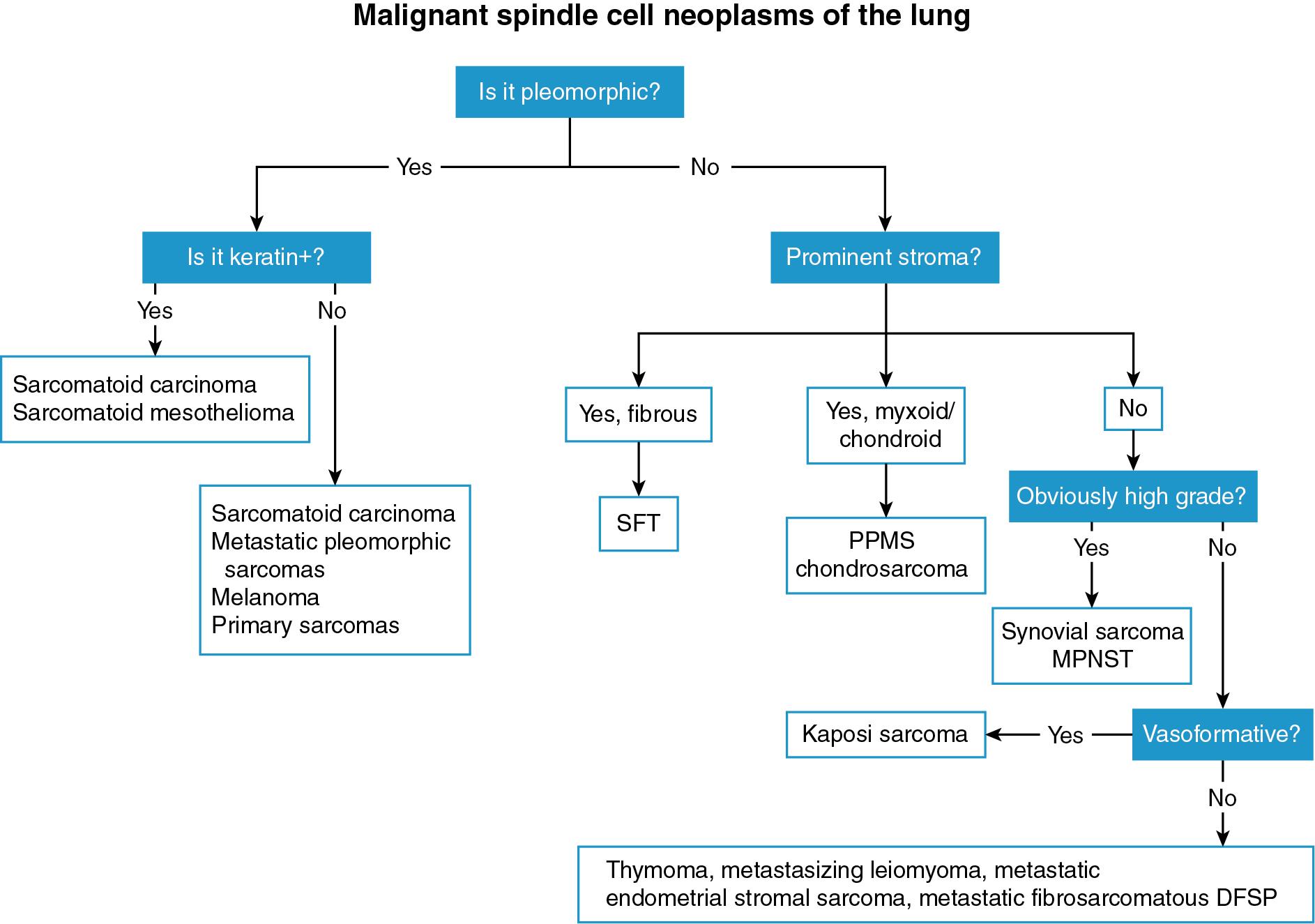
When a sarcomatoid neoplasm is encountered in the lung, it is important to remember that pulmonary malignancies overwhelmingly represent either carcinomas or metastatic tumors, and other tumor types are rare. Carcinomas represent 90% to 95% of primary pulmonary malignancies with neuroendocrine tumors representing approximately 5%; primary pulmonary mesenchymal tumors are exceedingly uncommon. When a malignant spindle cell proliferation presents as a solitary lung mass, sarcomatoid carcinoma generally leads the differential diagnosis, particularly in a patient with a history of smoking and no prior history of malignancy, and every effort should be made to determine whether the tumor displays morphologic or immunophenotypic evidence of epithelial differentiation. Helpful studies may include IHC using broad-spectrum cytokeratin cocktails (AE1/AE3, Cam5.2, OSCAR, etc.) and more specific antibodies (claudin-4, CK7, CK20, EMA, TTF-1, p40, etc.). The presence of even a limited amount of cytokeratin expression in a primary pulmonary sarcomatoid malignancy favors carcinoma in an appropriate clinical setting, although it should be kept in mind that sarcomatoid mesothelioma and many sarcomas can also express cytokeratins, and the significance of cytokeratin expression must be interpreted in the clinical and radiologic context. Even if cytokeratin expression is absent, the overwhelming preponderance of carcinomas among primary lung tumors mandates that any spindle cell malignancy be assumed to represent sarcomatoid carcinoma until proven otherwise, particularly in the small biopsy setting. When a definitive diagnosis is not possible and other morphologic mimics have been adequately excluded by IHC, the pathologist should consider issuing a descriptive diagnosis of “spindle cell malignancy, not further classifiable” accompanied by a comment that sarcomatoid carcinoma still leads the differential diagnosis if a primary lung tumor is suspected clinically.
As in any organ system, knowledge of clinical and imaging findings is often essential to accurately diagnose spindle cell neoplasms in the lung. As discussed in the previous section, almost all primary lung tumors represent carcinomas, and any pulmonary spindle cell malignancy should be regarded as a probable sarcomatoid carcinoma until proven otherwise. This general rule may not apply in all situations or patient populations, however. For example, in pediatric patients and young adults, other neoplasms are more common and sarcomatoid carcinoma and sarcomatoid mesothelioma are quite rare. In such patients, inflammatory myofibroblastic tumors and salivary-type neoplasms may be a consideration, and synovial sarcoma, undifferentiated round cell sarcomas (e.g., Ewing sarcoma, pleuropulmonary blastoma, or rhabdomyosarcoma), or other pediatric neoplasms may also enter the differential diagnosis. In immunocompromised hosts or patients with human immunodeficiency virus (HIV) infection, Kaposi sarcoma or nonneoplastic spindle cell proliferations (e.g., mycobacterial spindle cell pseudotumor) may merit consideration. Metastatic malignancy should also be considered, particularly when multiple lung nodules are present, as the lungs represent the most common site of metastasis for a wide variety of malignancies, including most sarcomas. Knowledge of a patient’s history of prior malignancy can greatly aid the pathologist, but it should be remembered that an absence of a history of malignancy does not exclude metastasis from a new occult primary. In other cases, a relevant clinical history may not be initially apparent, as in a woman presenting with a widely metastatic gynecologic neoplasm (e.g., metastasizing leiomyoma) who had a prior hysterectomy for “benign disease.”
Sarcomatoid carcinoma is an umbrella term representing a family of related high-grade malignancies, all of which are now believed to fundamentally represent epithelial malignancies showing evidence of epithelial-mesenchymal transition or transformation to spindle cell cytomorphology, mimicking true sarcomas. In the lung, three main subtypes of sarcomatoid carcinoma are currently recognized by the World Health Organization (WHO): pleomorphic carcinoma, carcinosarcoma, and pulmonary blastoma. , Although they are rare in an absolute sense, sarcomatoid carcinomas represent the most common primary spindle cell malignancies of the lung. True sarcomas are very infrequently seen in the lungs or tracheobronchial tree. Therefore a cytologically malignant primary spindle cell tumor of the lung is most likely to represent sarcomatoid carcinoma unless thorough ancillary studies indicate otherwise.
Controversy has existed for some time concerning the mechanisms through which obvious foci of lung carcinoma may be admixed with malignant but nondescript spindle cell elements or tissues with a “committed” sarcomatous differentiation pattern. Over time, morphologically similar tumors have been given a variety of designations in the upper and lower respiratory tracts. Historically, these diagnostic terms have included pulmonary blastoma , sarcomatoid carcinoma , spindle cell carcinoma , giant cell carcinoma , squamous cell carcinoma with pseudosarcomatous stroma , pseudosarcoma , carcinosarcoma , metaplastic carcinoma , biphasic sarcomatoid carcinoma , and monophasic sarcomatoid carcinoma , based largely on the specific microscopic attributes of the lesions in question and the conceptual leanings of the authors describing them. ,
Over 60 years ago, Saphir and Vass assessed the literature then extant on carcinosarcomas and concluded that they represented primary epithelial malignancies that had undergone divergent differentiation (“tumor metaplasia”). Thereafter, opposing publications on histogenesis espoused the opinion that biphasic neoplasms of the airways were “collision” tumors, or that they reflected the proliferation of nonneoplastic mesenchymal tissue components that were induced by the carcinomatous elements. At the turn of the last century, other authors , held to the same theories as those of Saphir and Vass. In the last four decades, results of studies using electron microscopy, immunohistochemistry, and molecular assays of clonality have supported the latter foresighted views of those pioneers convincingly. Hence, it is now believed that such tumors comprise a single morphologic spectrum of fundamentally epithelial tumors, regardless of their anatomic locations or specific histomorphologic elements. Most historical terms for these tumors have fallen out of favor and are now obsolete, while a few continue to be used (discussed further later). Regardless of the terminology applied, it should be recognized that all are approached in a similar fashion from a clinical standpoint and the value of retaining these morphologic subtypes as diagnostic terms mainly lies in the fact that the morphologic spectrum of sarcomatoid carcinomas is broad and these terms aid pathologists to recognize these challenging lesions and distinguish them from other tumor types.
Sarcomatoid carcinomas much more often arise in the large bronchi and peripheral lung fields than in the trachea, although the authors have indeed seen some lesions that arose above the carina. Most individuals with pulmonary sarcomatoid carcinomas are men, and most have a history of heavy smoking. , , The average patient age is 60 years. Clinical signs and symptoms produced by these tumors are directly associated with their specific locations. Obstructive endobronchial lesions characteristically cause refractory or recurrent pneumonia in the corresponding distal parenchyma, or they are associated with progressive dyspnea, cough, hemoptysis, and audible expiratory rhonchi over the affected lung field. , In contrast, sarcomatoid carcinoma in the peripheral lung often manifests no symptoms or, alternatively, presents with chest pain caused by invasion of the pleura and extrapulmonary soft tissue. As might be expected, central endobronchial tumors typically become symptomatic earlier in the disease course and are smaller than peripheral sarcomatoid carcinomas when they come to clinical attention; their average sizes are 6 cm and greater than 10 cm, respectively. ,
Despite their anaplastic nature, sarcomatoid carcinomas of the lung are surgically resectable in roughly 90% of cases, , and approximately one-half of patients with such neoplasms present with stage I disease. Paradoxically, however, the prognosis of pulmonary sarcomatoid carcinoma is still dismal. Overall 5-year survival is 20%, with a slightly better figure being associated with small, central endobronchial lesions. , , Metastatic sarcomatoid carcinoma of the lung involves the same organ sites that are affected by more usual forms of pulmonary nonsmall cell carcinoma, namely, the opposite lung, liver, bones, adrenal glands, and brain. , The metastases may exhibit either carcinomatous or sarcoma-like histologic configurations, or both. Adjuvant radiation treatment and chemotherapy are often utilized, but these measures have provided little benefit in general. , , Unfortunately, the targetable mutations that occur in pulmonary adenocarcinoma (i.e., EGFR mutations, ALK rearrangements, ROS1 rearrangements) only rarely occur in sarcomatoid carcinoma. There is hope on the horizon, however. MET exon 14 skipping mutations have been reported to occur with relative frequency in sarcomatoid carcinoma and may be an attractive therapeutic target. Sarcomatoid carcinomas also have a high rate of PD-L1 overexpression (up to 70%) and may respond to immune checkpoint inhibitor therapy. ,
Grossly, the lesions of pulmonary sarcomatoid carcinoma that are greater than 5 cm in size tend to exhibit central necrosis and hemorrhage, and they also demonstrate irregular permeation of the surrounding lung parenchyma ( Fig. 15.2 ). , Tumors that are smaller and located within a bronchus often exhibit a polypoid appearance with attachment to the subjacent mucosa by a relatively narrow stalk of tissue ( Fig. 15.3 ) ; sarcomatoid carcinomas in the peripheral lung parenchyma may have the gross appearance of conventional adenocarcinomas (see Fig. 15.2 ).

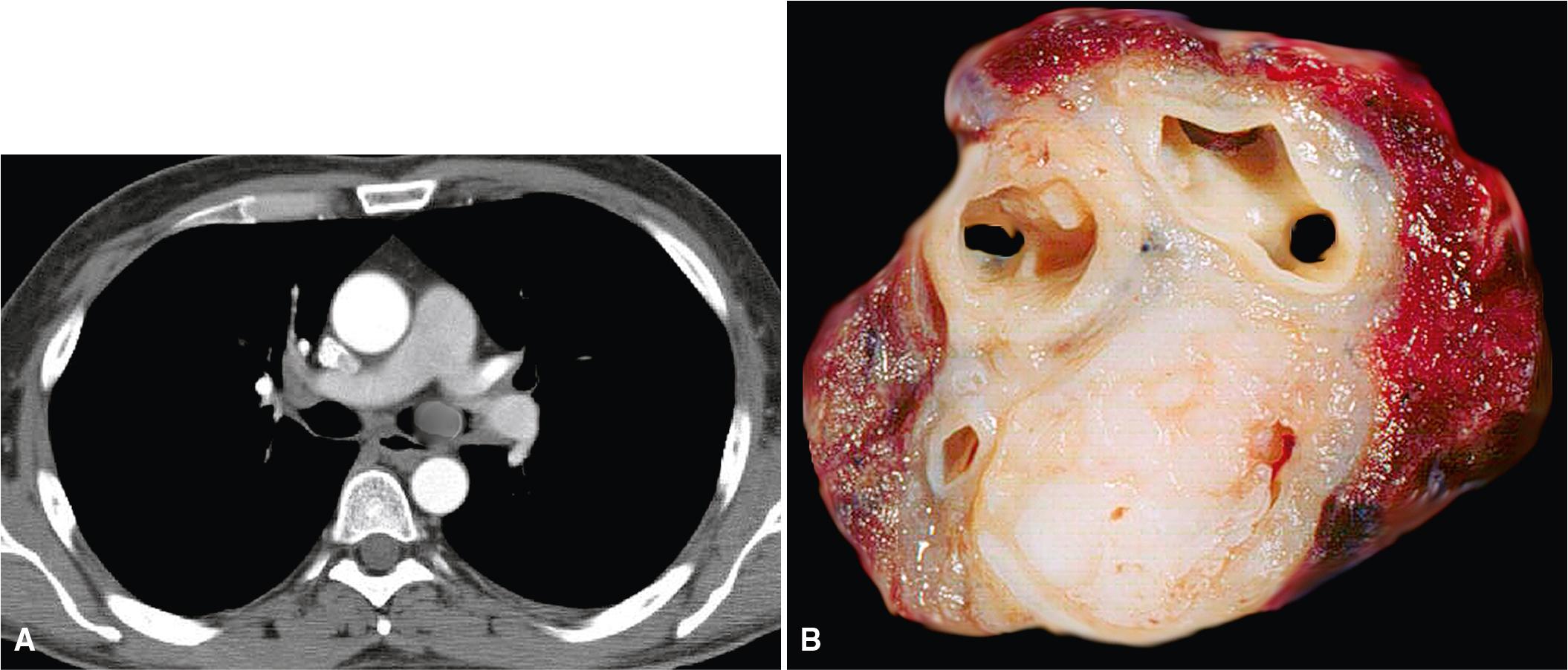
Sarcomatoid carcinomas are constituted microscopically by malignant spindled and/or highly pleomorphic cells (i.e., tumor giant cells), sometimes but not always admixed with one or more obvious carcinomatous components ( Fig. 15.4 ). Whether or not an overtly carcinomatous component is present, the sarcomatoid component of sarcomatoid carcinoma is generally composed of markedly heterogeneous spindled cells with nuclear atypia and growth patterns that can be quite variable. Histologically, the appearance may range from a fibromatosis-like or low-grade fibrosarcoma-like tumor—with relatively bland nuclear features, sparse mitoses, moderate-to-rich collagen matrix deposition, and a herringbone growth pattern—to others in which pleomorphic and frankly anaplastic giant cells are admixed with fusiform elements showing dense cellularity, coarse chromatin, prominent nucleoli, and numerous mitoses ( Fig. 15.5 ), resembling undifferentiated pleomorphic sarcomas of soft tissues. , , , The later more highly pleomorphic and obviously malignant pattern is far more common. Neoplastic spindle cells may infiltrate the submucosa of small and medium-sized bronchi, which nevertheless tend to retain their mural cartilage plates and mucosal integrity. , Rare examples of sarcomatoid carcinoma may demonstrate extravasated erythrocytes between relatively bland spindled tumor cells, simulating the characteristics of Kaposi sarcoma or even nodular fasciitis. Cytologically bland, osteoclast-like giant cells may also be present ( Fig. 15.6 ). , ,
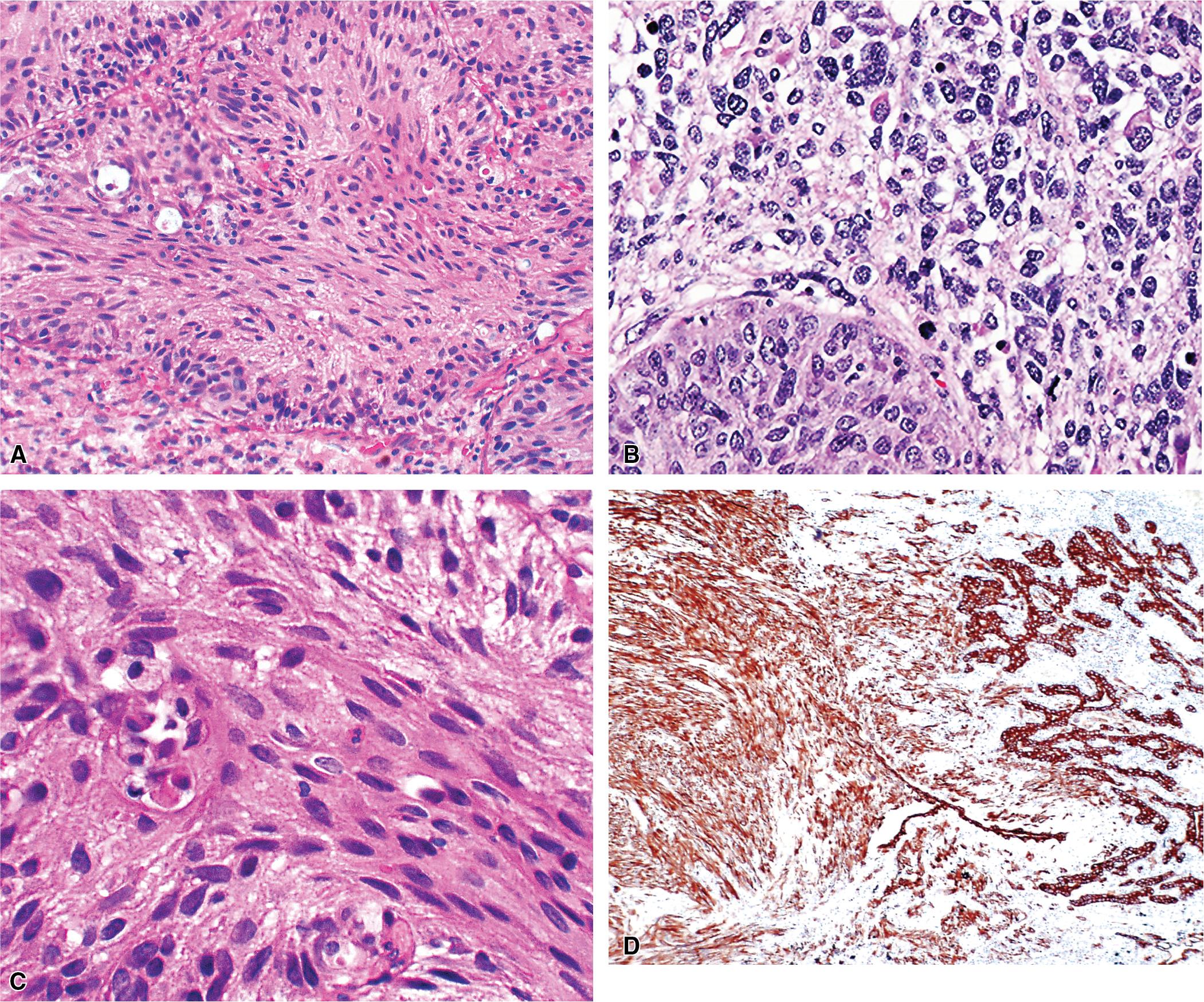

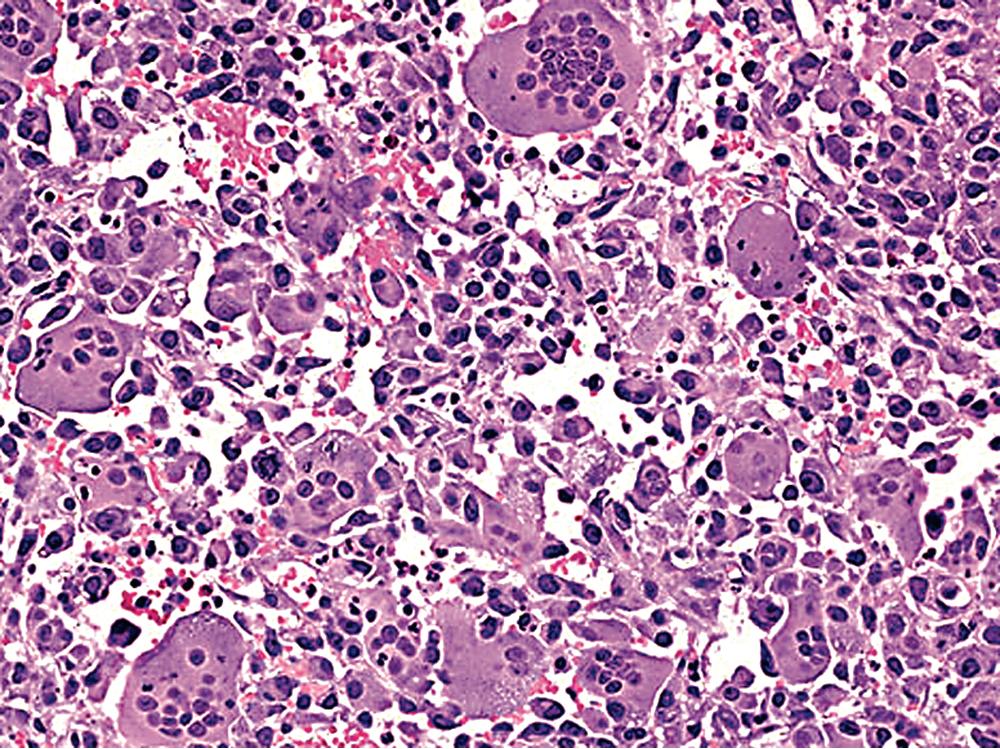
Immunophenotypically, sarcomatoid carcinomas often display nonspecific findings. Expression of one or more cytokeratins or other markers of epithelial differentiation is characteristic, but this may be patchy or focal and may be missed if not carefully sought, and testing using multiple antibodies or antibody cocktails may be required to convincingly demonstrate epithelial differentiation in the tumor. IHC is often essential in the workup of tumors showing sarcomatoid morphology in the lung, although IHC is not required in all cases, particularly cases showing an overt carcinomatous component (e.g., adenocarcinoma or squamous cell carcinoma) with transition to spindled morphology. Expression of other more specific markers typically associated with lung carcinomas (e.g., TTF-1, p40) can also be helpful to establish the diagnosis in an appropriate clinical setting ( Fig. 15.7 ), but the absence of such markers does not exclude the diagnosis. When a purely sarcomatoid tumor is encountered with no overt carcinomatous component, other immunohistochemical studies may be helpful to exclude other tumor types (e.g., metastatic melanoma, true sarcomas, and even hematolymphoid neoplasms in some cases), but oftentimes the immunophenotype of the spindle cell component is nonspecific and a final diagnosis may rest on a combination of clinical, radiologic, morphologic, and immunophenotypic findings.
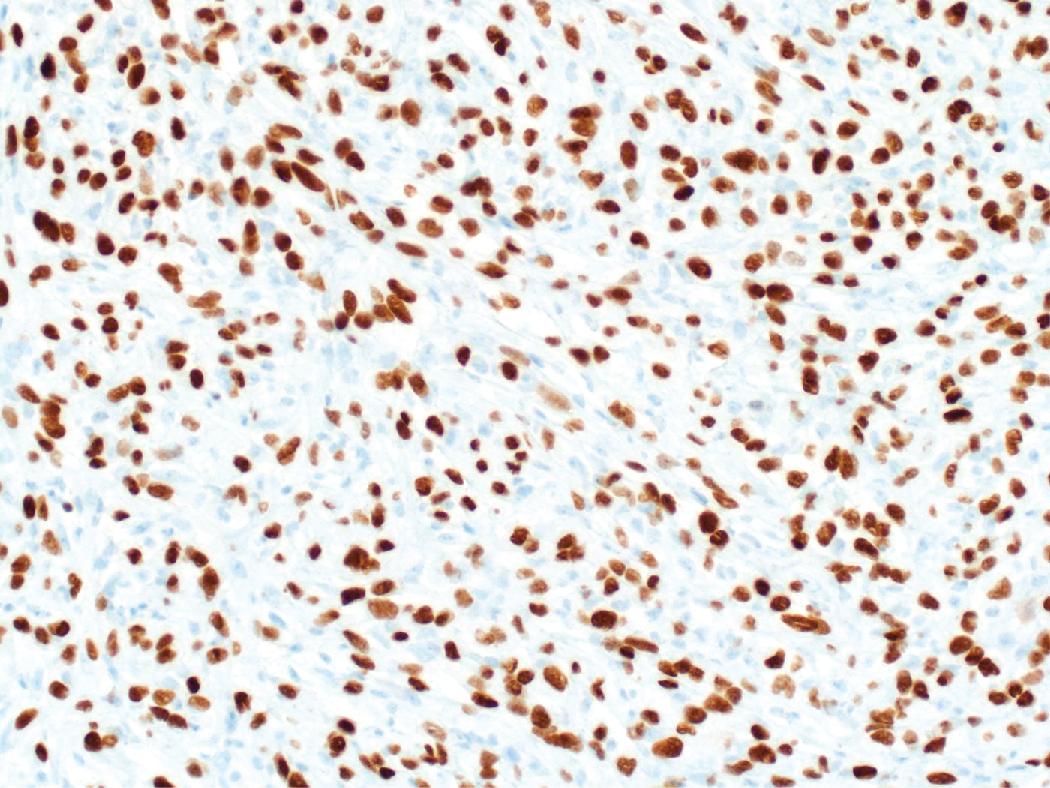
There are several histomorphologic subtypes of sarcomatoid carcinoma of the lung formally recognized by the WHO that deserve additional discussion. These include the tumors known as pleomorphic carcinoma (including so-called giant cell carcinoma and spindle cell carcinoma variants), carcinosarcoma , and pulmonary blastoma .
Pleomorphic carcinoma is a term applied to sarcomatoid carcinomas showing not only a sarcomatoid component but also one or more overtly carcinomatous components. The latter are generally inconspicuous and variably distributed; in roughly 40% of cases such foci are rare and require extensive sampling to document their presence. Carcinomatous elements may represent any histologic subtype of nonsmall cell lung carcinoma, including squamous cell carcinoma, adenocarcinoma, adenosquamous carcinoma, and/or large cell carcinoma (see Fig. 15.4 ). , Rare examples show mixtures of several carcinoma morphotypes. Zones of transition between epithelial and sarcomatoid components are usually evident, at least focally. When a high-grade neuroendocrine carcinoma component is encountered (i.e., small cell carcinoma or large cell neuroendocrine carcinoma), such lesions should instead be classified as combined small cell or large cell neuroendocrine carcinomas, respectively, also having sarcomatoid carcinoma components as this designation will have treatment implications.
Some sarcomatoid carcinomas display no conventional light microscopic evidence of epithelial differentiation whatsoever and are composed purely of malignant spindle cells and/or tumor giant cells. Historically, such tumors were termed spindle cell carcinoma or giant cell carcinoma depending on the morphology of the tumor cells ( Fig. 15.8 ), but these terms are now simply listed as histologic variants of pleomorphic carcinoma in the recently updated WHO classification of lung tumors. Giant cell carcinomas and spindle cell carcinomas are composed solely of highly pleomorphic malignant giant cells or nondescript malignant spindle cells, respectively. Their carcinomatous nature is discerned only after immunohistochemical investigations have been done, but it is usually suspected beforehand because of the clinical and gross characteristics of the lesions.
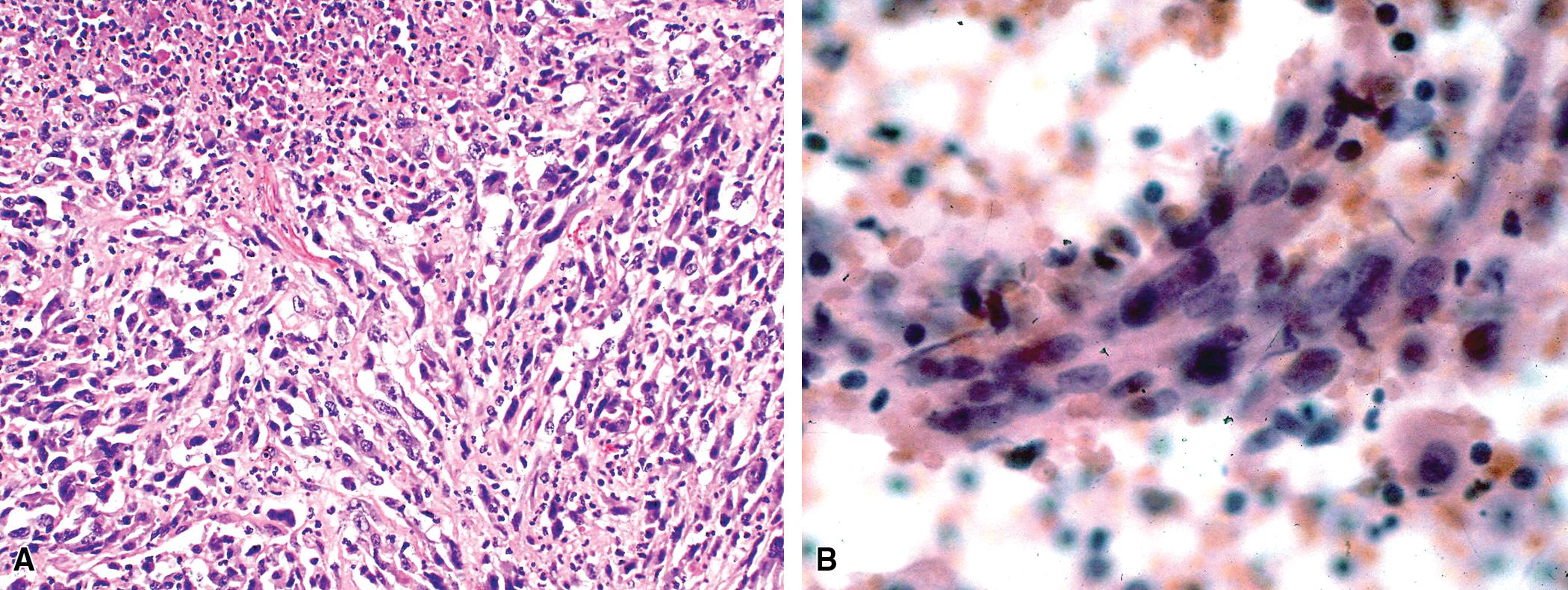
Carcinosarcomas represent yet another distinctive morphologic variant of pulmonary sarcomatoid carcinoma and are characterized by the presence of heterologous elements of frank sarcomatous differentiation, in addition to overtly carcinomatous elements. Thus they are analogous to carcinosarcomas of the uterus, ovaries, and other female genital sites. , Carcinosarcomas may exhibit microscopic foci that simulate embryonal or adult-type pleomorphic rhabdomyosarcoma, containing proliferations of closely apposed compact round cells with a slightly myxoid background, or large “strap” cells with cytoplasmic eosinophilia and cross-striations, respectively ( Fig. 15.9 ). , , , , This is associated with expression of markers of rhabdomyoblastic differentiation (i.e., desmin, myogenin, MyoD1). Other carcinosarcomas contain frankly osteosarcomatous, chondrosarcomatous, leiomyosarcomatous, or even angiosarcomatous elements. , , The obviously carcinomatous elements in these lesions usually take the form of squamous cell carcinoma, but lesions with glandular or neuroendocrine differentiation have also been reported. , , As already mentioned, tumors with a high-grade neuroendocrine carcinoma component should be classified as combined neuroendocrine carcinomas with carcinosarcomatous components, as this will have treatment implications. Transitional zones between obvious epithelial foci, nondescript sarcomatoid areas, and frankly sarcomatous heterologous components are often evident.

Pulmonary blastoma is the final morphologic variant of sarcomatoid carcinoma deserving additional discussion. Since its initial descriptions , pulmonary blastoma was often regarded by some observers as the pulmonary counterpart of primitive childhood tumors of other organs. , This erroneous historical view was fostered in part by confusion of pulmonary blastoma with pleuropulmonary blastoma (discussed later in this chapter), the latter of which is primarily seen in children and adolescents. Pulmonary blastoma is a biphasic neoplasm, containing a mixture of tubular epithelial cell profiles and compact groupings of nondescript bluntly fusiform spindle cells with a blastema-like configuration ( Fig. 15.10 ). , , These resemble the elements of renal Wilms tumors. In distinction from pulmonary blastoma, pleuropulmonary blastoma altogether lacks epithelial differentiation and may instead show rhabdomyoblastic or chondrosarcomatous differentiation. Moreover, pulmonary blastoma shows no particular disease associations and occurs overwhelmingly in adults with clinical characteristics overlapping with ordinary nonsmall cell carcinomas, whereas pleuropulmonary blastoma is linked in a familial fashion to a number of other malignant neoplasms and nonneoplastic disorders. For this reason, pulmonary blastoma is now regarded as a variant of sarcomatoid carcinoma unrelated to pleuropulmonary blastoma and other pediatric embryonic malignancies. , , ,
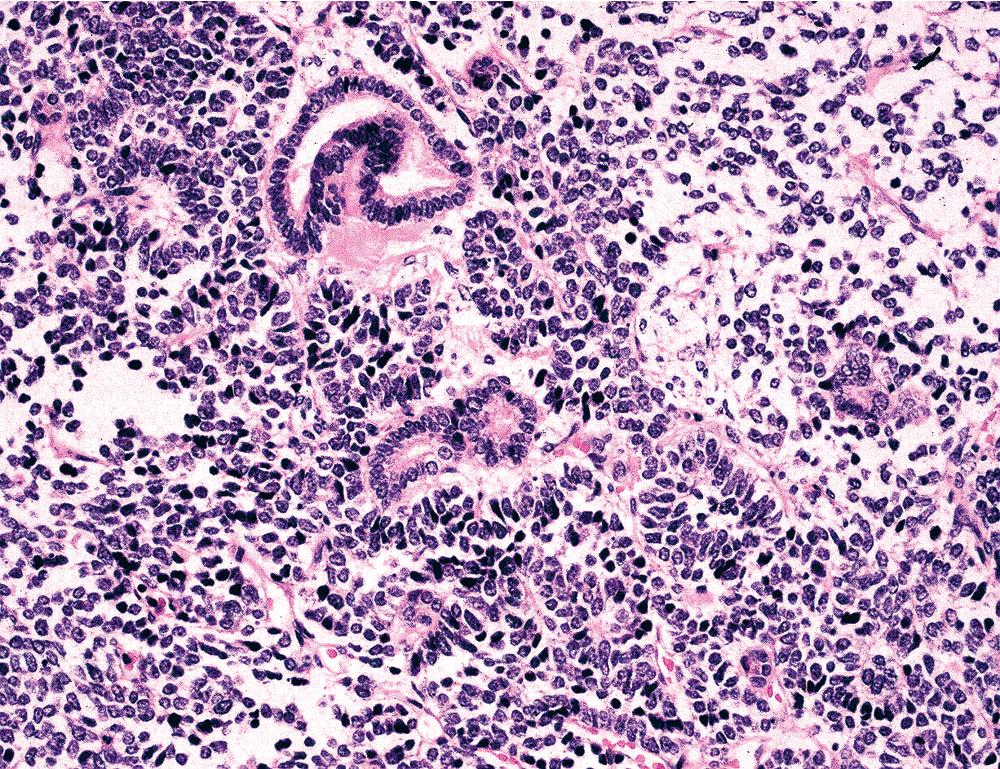
Pulmonary blastoma may demonstrate the same range of epithelial and mesenchymal differentiation that is seen in other pulmonary sarcomatoid carcinomas. , , In many respects, the epithelial elements in pulmonary blastoma resemble primitive glandular elements in the developing fetal lung or even endometrioid adenocarcinoma, with tubular structures lined by stratified columnar cells having glycogen-rich clear cytoplasm. , Luminal mucin may be present in those cellular arrays, and squamous morules are sometimes also evident. Interestingly, “occult” neuroendocrine differentiation is a rather common finding in the epithelial components of pulmonary blastoma, with immunoreactivity for neuroendocrine markers. , There is significant overlap of microscopic features between pulmonary blastoma and so-called “fetal adenocarcinoma” of the lung ( Fig. 15.11 ). Fetal adenocarcinoma differs from pulmonary blastoma in its lack of a malignant stromal component. , , Sarcomatoid elements of pulmonary blastoma are usually nondescript morphologically and blastema- or fibroblast-like. However, examples of this tumor have been documented in which heterologous rhabdomyoblastic, leiomyosarcomatous, or osteochondrosarcomatous elements were present. , This observation serves to further solidify the linkage of pulmonary blastoma to other sarcomatoid carcinomas. ,
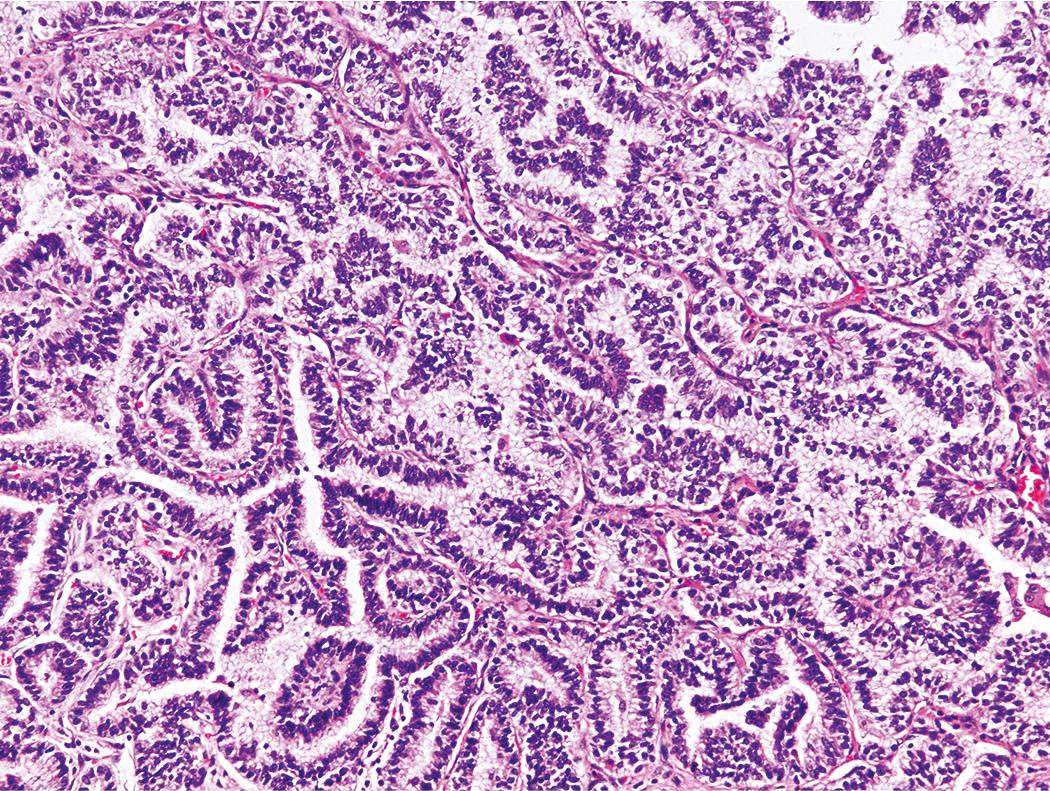
The clinical behavior of pulmonary blastoma is difficult to determine with certainty given the rarity of this tumor and confusion in the older literature with pleuropulmonary blastoma, but mortality figures of 30% to 70% have been reported, with death usually being due to distant metastases. , , Metastatic deposits of pulmonary blastoma may have a purely epithelial, purely mesenchymal-like, or biphasic appearance, as is true of other sarcomatoid carcinomas.
The differential diagnosis of pulmonary sarcomatoid carcinoma principally centers on distinction from sarcomatoid mesothelioma and true sarcomas, which are discussed later in this chapter. As a particular word of caution, it should be noted that sarcomatoid mesothelioma and synovial sarcoma may be very similar to sarcomatoid carcinoma, and all tumors show variable expression of cytokeratins. Expression of TTF-1 or p40 favors sarcomatoid carcinoma in an appropriate clinical context; conversely, expression of GATA3 or D2-40 can support a diagnosis of sarcomatoid mesothelioma, although these markers are not entirely specific (GATA3 is also expressed by carcinomas arising in the breast and urinary bladder, and D2-40 can be expressed occasionally in carcinomas). Radiologic findings are often more helpful than morphologic observations in making the distinction between sarcomatoid carcinoma and sarcomatoid mesothelioma. The marked propensity for synovial sarcoma to affect children and young adults, its typical t(X;18) (p11.2;q11.2) cytogenetic aberration, , its usual striking nuclear monotony, and nuclear labeling for TLE1 protein (not often seen in carcinomas) are crucial points in its distinction from pulmonary sarcomatoid carcinoma. Of course, nuances of histologic appearances and radiographic characteristics are also valuable in this specific differential diagnostic setting. As a final word of caution, it should also be remembered that some cases of anaplastic large cell lymphoma may show variable cytokeratin expression and a subset of carcinomas can express CD30, representing dangerous diagnostic pitfalls. Expression of other relevant hematolymphoid markers (e.g., CD2, CD4, CD25) and ALK can enable distinction of anaplastic large cell lymphoma with aberrant cytokeratin expression from sarcomatoid carcinoma.
Regardless of histologic subtype—sarcomatoid or otherwise—the clinical features of intrathoracic mesothelioma are the same. Pleural mesothelioma typically affects adult men, although women and rarely even children are represented in the patient population with this neoplasm. , The most common presenting symptoms and signs are pleuritic-type chest pain and progressive shortness of breath, with a pleural effusion on chest radiographs. An influenza-like syndrome is occasionally reported in association with pleural mesothelioma. The lesion most commonly takes the form of multiple nodules and plaques on the serosal surfaces but may occasionally be represented by a solitary localized mass ( Fig. 15.12 ). Later in the clinical course, encasement of the lung by confluent neoplastic tissue is seen ( Fig. 15.13 ).
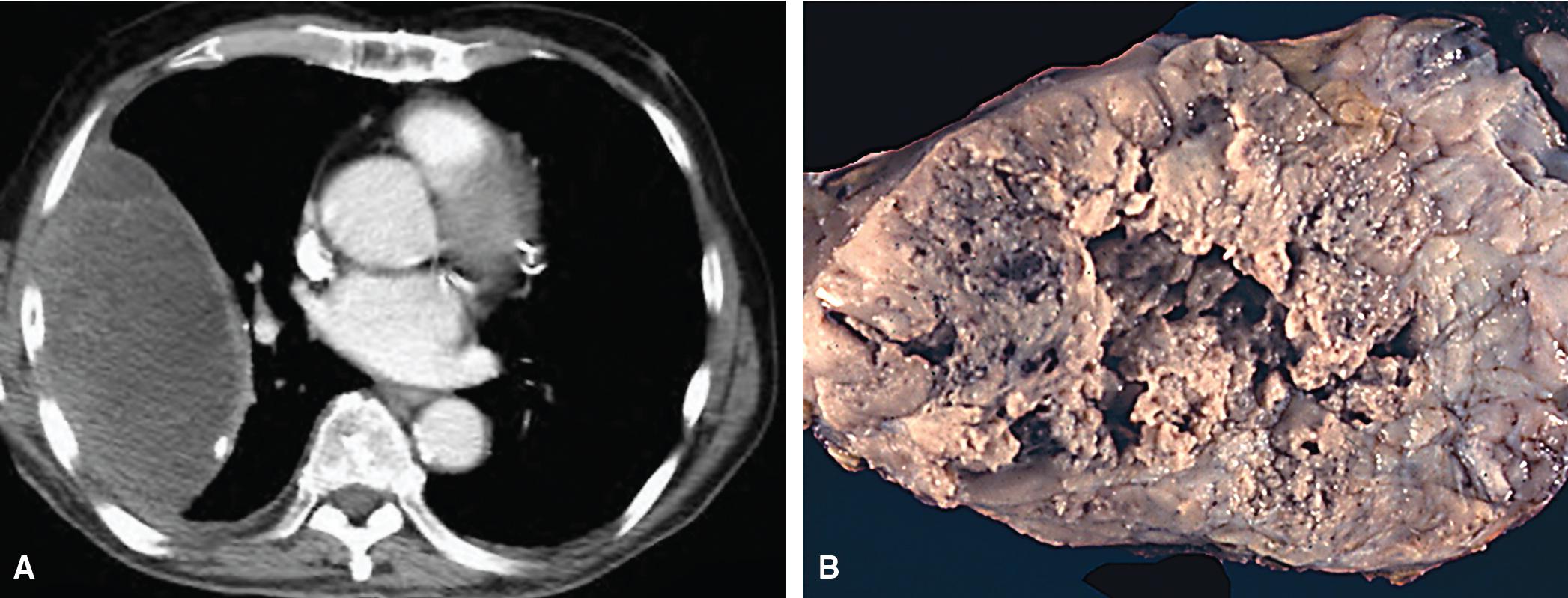
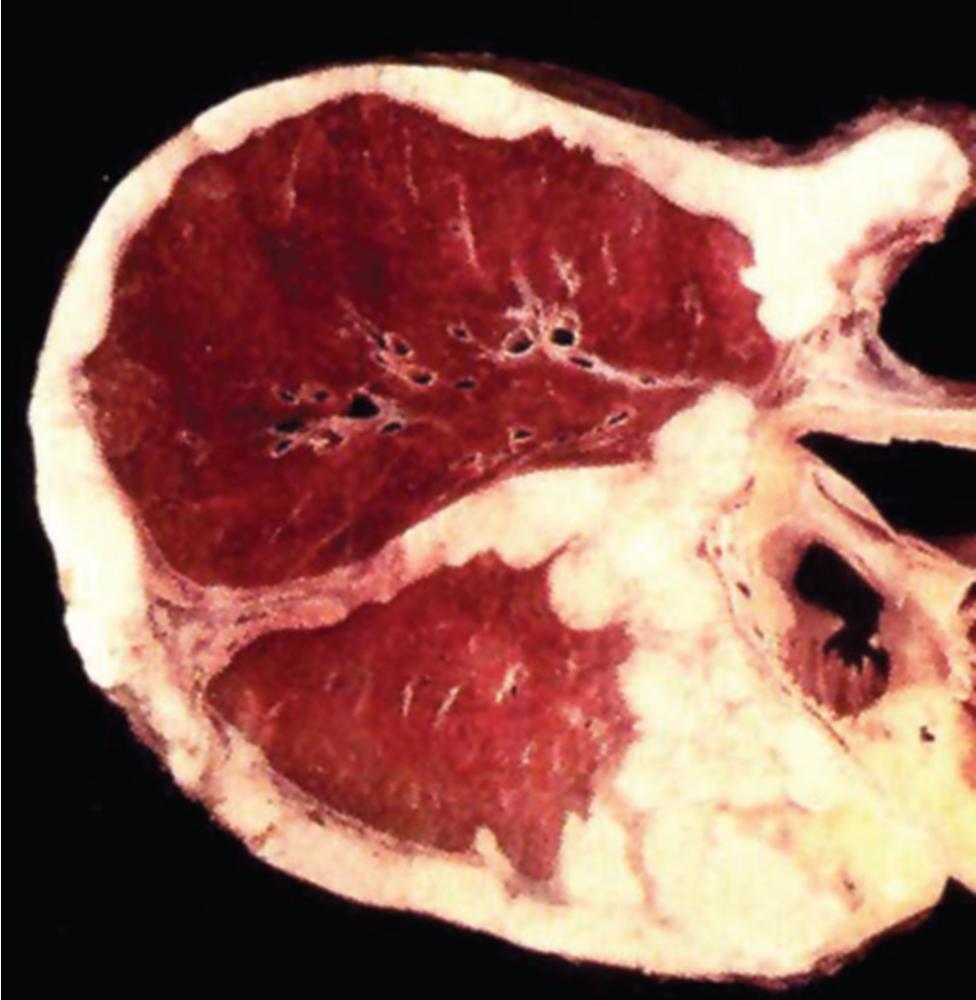
Roughly 50% to 70% of pleural mesotheliomas can be objectively related to prior occupational-level asbestos exposure. In those instances, 85% to 90% of patients will show the presence of pleural plaques or pleural calcifications, or quantitative pulmonary asbestos fiber burdens clearly in excess of background levels, serving as tangible markers of such exposure. These findings are much more reliable than patients’ historical accounts of occupational conditions and should be sought in all instances before concluding objectively that a given mesothelioma is indeed asbestos-related.
Other accepted pathogenetic factors in mesothelioma cases include inhalational exposure to erionite, chronic infection of the pleural spaces (e.g., in tuberculous pleuritis), and prior therapeutic radiation. , Similar to examples of peritoneal mesothelioma that have been linked causally to chronic recurrent peritonitis in the context of familial Mediterranean fever, the authors have observed several pleural tumors that arose in the background of chronic pleuritis in patients with connective tissue disease (e.g., systemic lupus erythematosus). Mesothelioma can also arise in patients with the BAP1 tumor predisposition syndrome, a rare hereditary syndrome caused by heterozygous germline variants in the BAP1 (BRCA1 associated protein 1) gene that has also been associated with increased risk for development of uveal and cutaneous melanomas, renal cell carcinoma, cholangiocarcinoma, and basal cell carcinoma. There has been interest in the potential role of simian virus-40 in the development of mesothelioma, but conclusions on whether that agent is indeed causative are still unsettled. At least 30% of pleural mesotheliomas are idiopathic.
Mesotheliomas can display a surprising variety of histopathologic patterns , , but are generally classified into epithelioid , sarcomatoid , and biphasic types, with the latter representing those tumors having both epithelioid and sarcomatoid components. Numerous morphologic variants of epithelioid mesothelioma can occur, including tumors with clear cell, deciduoid, rhabdoid, small cell, signet ring cell, and/or pleomorphic cytology, and architectural patterns including tubulopapillary, trabecular, adenomatoid, solid, and/or micropapillary growth, which are reviewed in detail in Chapter 21 .
Like their epithelioid counterparts, sarcomatoid mesotheliomas can also display a variety of histologic patterns that simulate other spindle cell neoplasms involving the pleura ( Figs. 15.14 and 15.15 ). Given the variety of morphologies that can be encountered, as well as the uncommon occurrence of sarcomatoid mesothelioma, it is not surprising that this diagnosis can be challenging for pathologists. In some cases, the malignant spindle cells of sarcomatoid mesothelioma are frankly malignant and pleomorphic with fascicular or haphazard growth, whereas in other cases they can be deceptively bland from a cytologic standpoint. When an atypical spindle cell proliferation in the pleura is encountered, establishing benignity or malignancy is of primary importance and should precede further characterization of histogenesis. Reactive or inflammatory pleural processes can produce florid mesothelial hyperplasia with striking reactive mesothelial atypia and marked and diffuse fibrotic pleural thickening that can closely mimic malignancy. Immunohistochemistry for cytokeratins can greatly aid in the distinction between benign and malignant spindle cell proliferations in the pleura by highlighting the lesion’s architecture and growth patterns. Disorganized and/or frankly tumefactive growth is typical of sarcomatoid mesotheliomas, and invasion into lung tissue, fat, or the chest wall is usually the most reliable feature that enables recognition of a malignant process. Immunohistochemical testing for aberrant loss of expression of BAP1 or methylthioadenosine phosphorylase (MTAP) and/or fluorescence in situ hybridization for homozygous loss of CDKN2A (p16) may be helpful in some cases, as aberrant loss of these markers occurs in a substantial subset of mesotheliomas but not in benign reactive mesothelial proliferations. , However, BAP1 loss is much more common in epithelioid mesothelioma than in sarcomatoid mesothelioma, which may limit its utility in this setting.
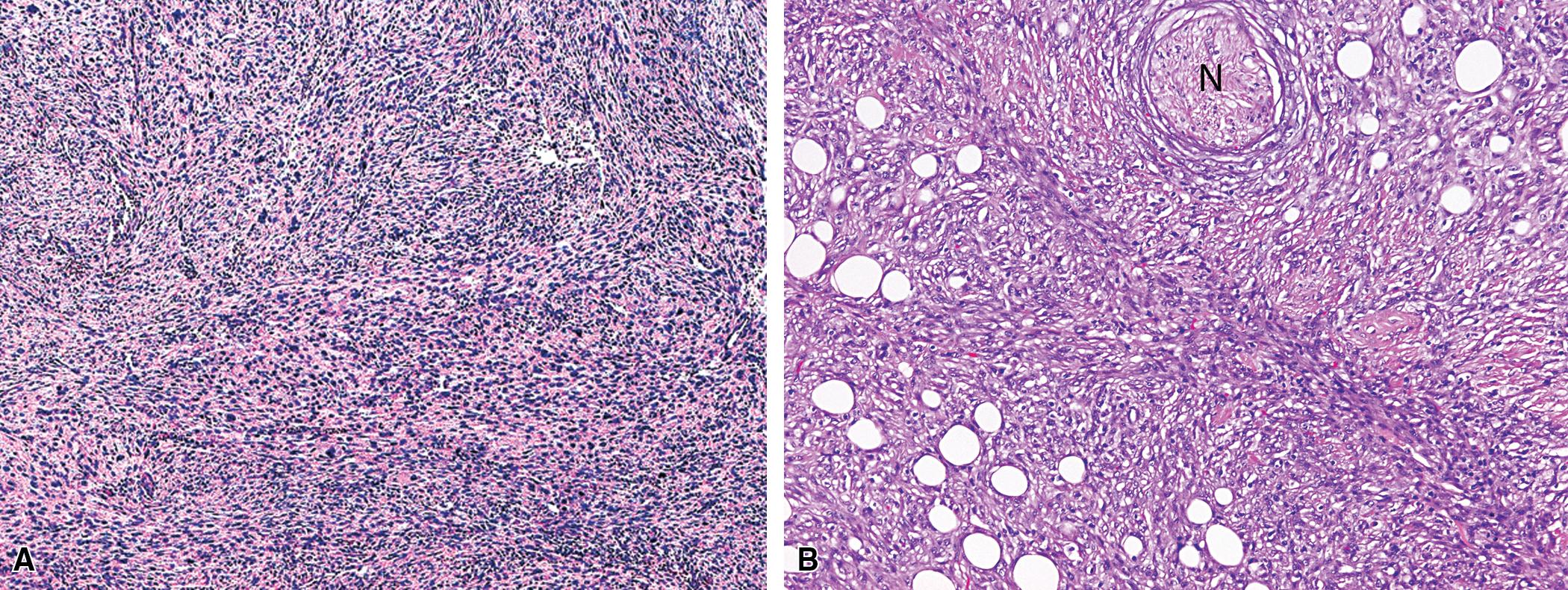
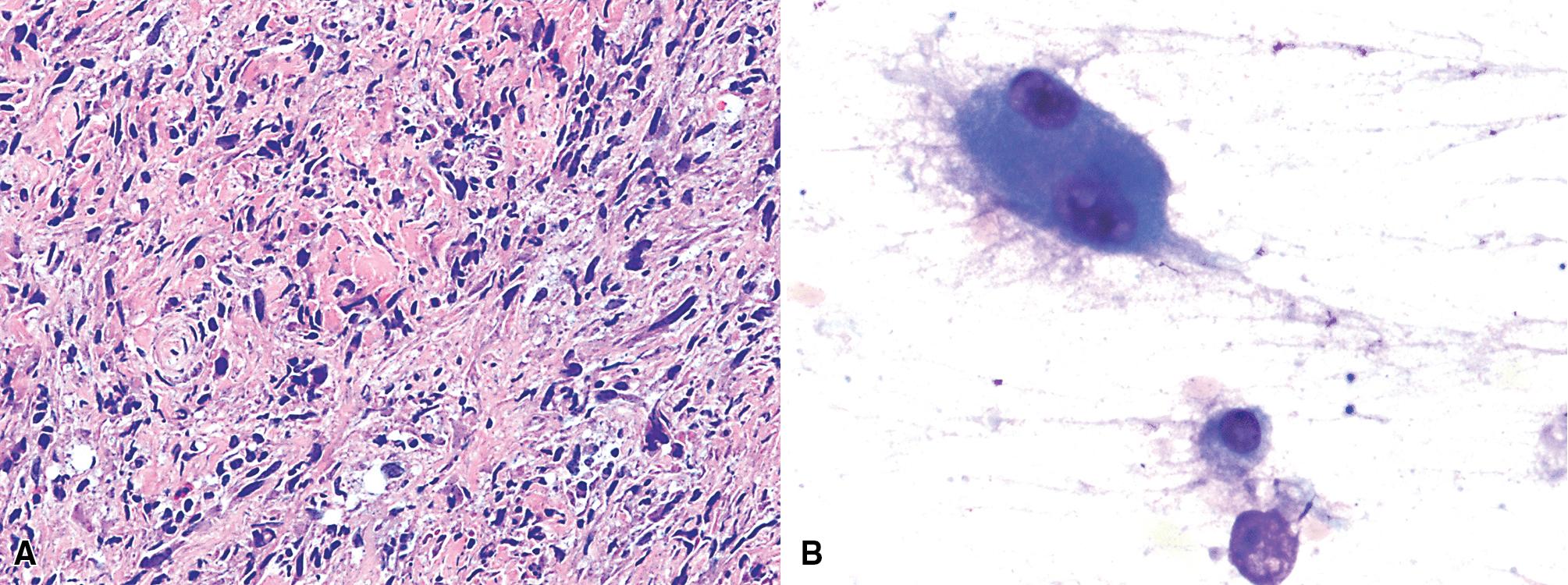
The differential diagnosis of sarcomatoid mesothelioma depends on the features encountered, but distinction from sarcomatoid carcinoma may not be possible on histologic grounds alone, given the fact that morphologic features and immunophenotype of these two tumor types may be identical. It is helpful to remember that sarcomatoid carcinoma is far more likely to be encountered in the lungs than primary sarcomas, and sarcomatoid carcinoma can involve the pleura by direct invasion or metastasis. When a biphasic tumor is encountered, the diagnosis of biphasic mesothelioma is often facilitated by characterizing the epithelioid component, for which many useful immunohistochemical markers are available, but diagnosis of a purely sarcomatoid tumor can be more problematic. A panel of immunohistochemical tests with a minimum of two mesothelial and two carcinoma markers can readily distinguish epithelioid mesothelioma from nonsmall cell carcinoma in most cases, with CK5/6, WT-1, calretinin, and D2-40 representing recommended mesothelial markers and claudin-4, MOC-31 or BerEP4, B72.3, CEA, CD15, and BG8 representing recommended carcinoma markers. Unfortunately, most of these markers are negative in sarcomatoid pleural lesions and therefore unhelpful in their distinction. Likewise, electron microscopy is not very helpful in this context, as sarcomatoid mesothelioma tends to lack the specialized ultrastructural features that are characteristic of epithelioid mesothelioma. Recently, GATA3 has emerged as a useful marker that can support a diagnosis of sarcomatoid mesothelioma in an appropriate clinical context, if strong diffuse nuclear immunoreactivity is seen ( Fig. 15.16 ), but it should be remembered that GATA3 can also be expressed by sarcomatoid carcinomas arising in the urinary bladder or breast, and weak immunostaining for GATA3 can occur in a variety of neoplasms. Calretinin and D2-40 immunostains can be helpful if they are positive ( Fig. 15.17 ), but these markers are expressed by less than half of sarcomatoid mesotheliomas. Immunoreactivity for p40 or TTF1 (particularly when detected with the 8G7G3/1 clone) favors sarcomatoid carcinoma. In cases having an indeterminate phenotype, distinction between sarcomatoid mesothelioma and sarcomatoid carcinoma may require correlation with clinical and imaging findings. As already discussed, sarcomatoid carcinoma with secondary pleural involvement would be more likely in a patient with a bulky lung mass and pleural disease, while mesothelioma would be more likely with diffuse pleural disease in the absence of pulmonary parenchymal involvement.
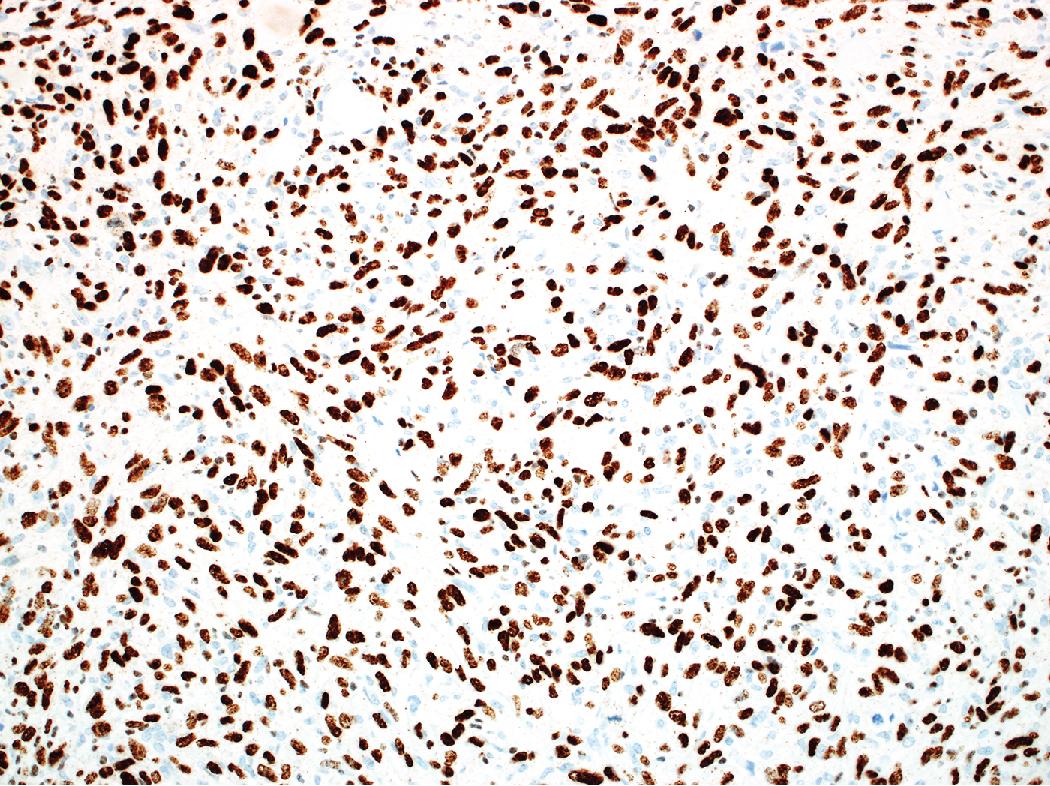
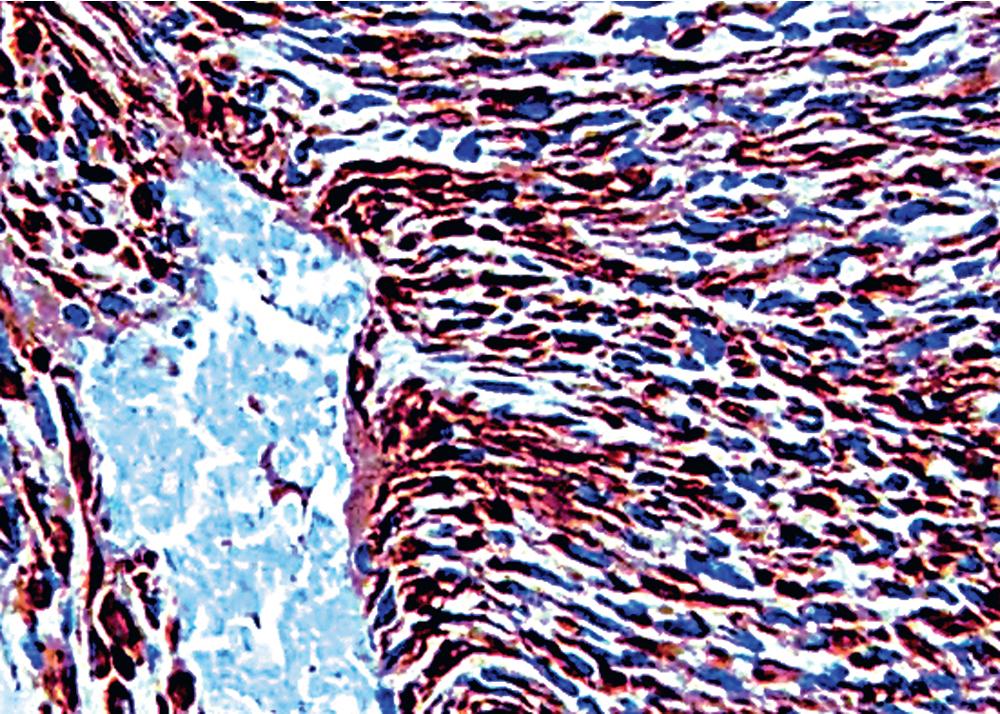
Depending on the morphologic features encountered, primary or metastatic sarcomas may also enter the differential diagnosis. Although primary sarcomas in the lung are rare, primary chest wall sarcomas can be an important consideration in some cases. When a biphasic or purely spindled tumor is encountered, biphasic or monophasic synovial sarcoma is an important diagnostic alternative, particularly when the spindled component is monotonous rather than pleomorphic as is characteristic of translocation-associated sarcomas. Distinction between mesothelioma and synovial sarcoma can be challenging in occasional cases, because both can express cytokeratin in a patchy fashion, and the immunophenotypes of the two tumors are otherwise quite similar. Negativity for TLE1 argues against synovial sarcoma, and can be used as a helpful “rule out” stain; however, TLE1 expression is not specific and can be seen in other neoplasms. Therefore, fluorescence in situ hybridization (FISH) testing for SS18 gene rearrangements or next generation sequencing/PCR testing for SS18 - SSX1/2 transcripts may be necessary to diagnose synovial sarcoma with certainty. ,
Occasionally, heterologous elements can occur in sarcomatoid mesothelioma, including areas of frankly osteosarcomatous, chondrosarcomatous, or rhabdomyosarcomatous differentiation. The presence of a component displaying mesothelial differentiation can aid the distinction from primary and metastatic sarcomas when such elements are encountered, but such tumors should also be distinguished from carcinosarcoma, a subtype of sarcomatoid carcinoma harboring one or more heterologous sarcomatous elements in addition to a demonstrable nonsmall cell carcinoma component. Rarely, localized sarcomatoid mesotheliomas may resemble solitary fibrous tumors of the pleura ; in those cases, immunoreactivity for CD34 and STAT6 can be used to exclude a diagnosis of mesothelioma. ,
Several variants of sarcomatoid mesothelioma merit further consideration. Desmoplastic mesothelioma is characterized by neoplastic spindle cells that are deceptively bland from a cytologic standpoint, set in a densely collagenized fibrohyaline matrix with a so-called “patternless pattern” of disorganized or storiform growth causing diffuse fibrous pleural thickening ( Fig. 15.18 ). The differential diagnosis for desmoplastic mesothelioma includes chronic fibrosing pleuritis (fibrous pleurisy); the presence of architectural disorganization, bland necrosis, or invasion of lung or soft tissue points to a diagnosis of mesothelioma, but in the authors’ experience, these features can be subtle and are easily missed if they are not specifically sought. IHC for cytokeratins can aid the recognition of architectural disorganization and invasion into lung or soft tissues and is often the most valuable ancillary test that can be performed in such cases ( Fig. 15.19 ).
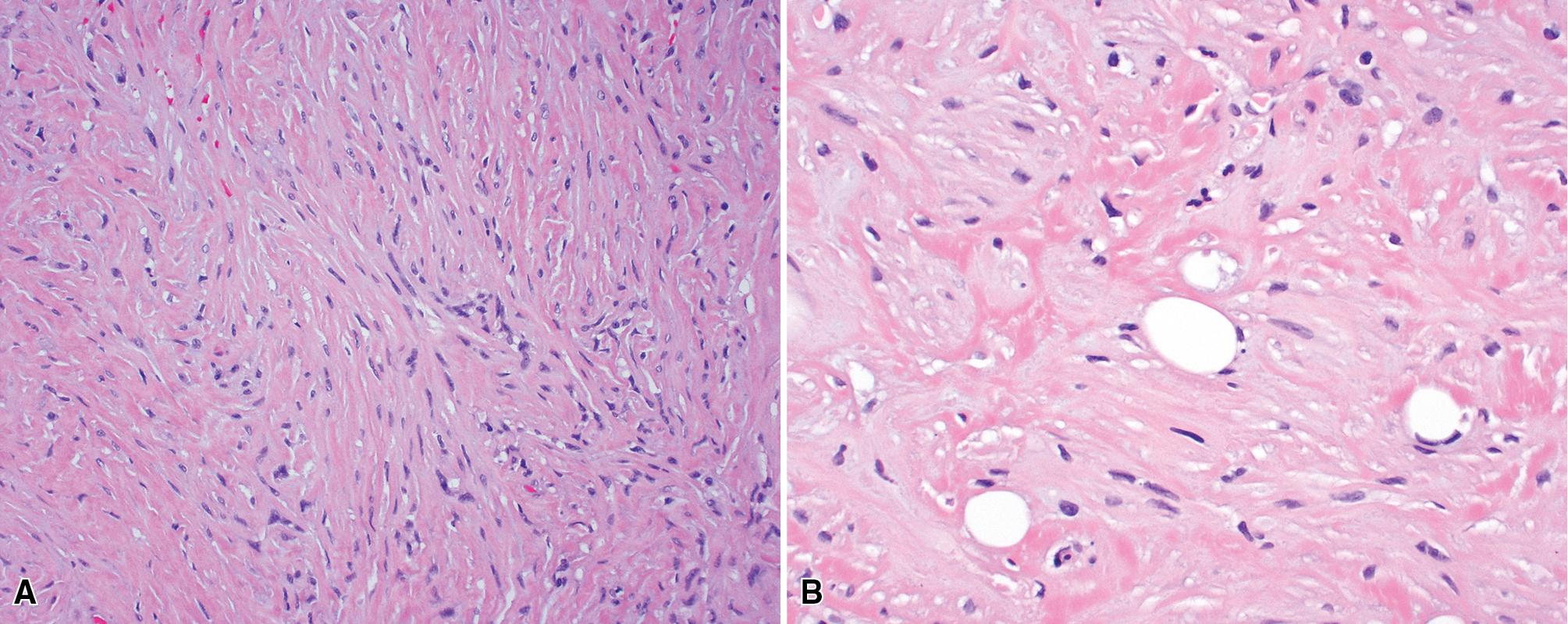
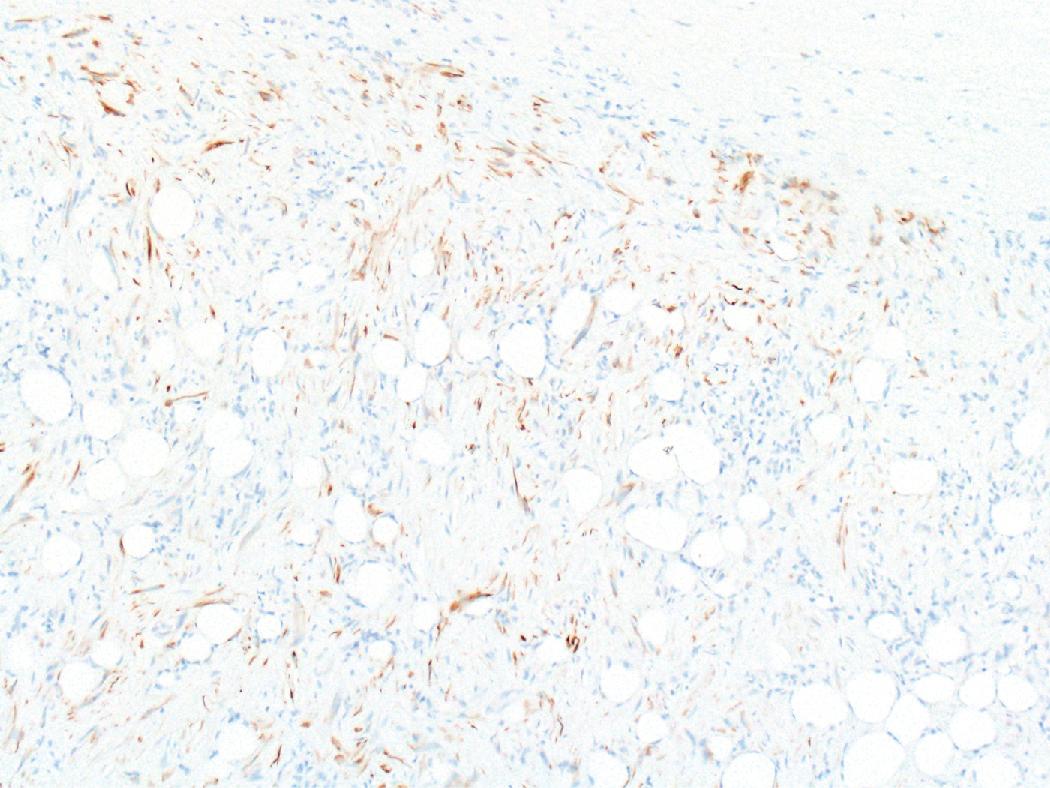
Transitional mesothelioma is a variant of mesothelioma characterized by the presence of plump yet elongated cells with an appearance intermediate between epithelioid and sarcomatoid morphology ( Fig. 15.20 ). Historically, such tumors were considered to represent a variant of epithelioid mesothelioma, but more recent data indicates that the transitional subtype of mesothelioma behaves in an aggressive fashion similar to sarcomatoid mesothelioma. For this reason, transitional mesothelioma is now recognized as a subtype of sarcomatoid mesothelioma by the WHO, and identification of areas with transitional morphology in an otherwise epithelioid tumor should prompt a diagnosis of biphasic mesothelioma.
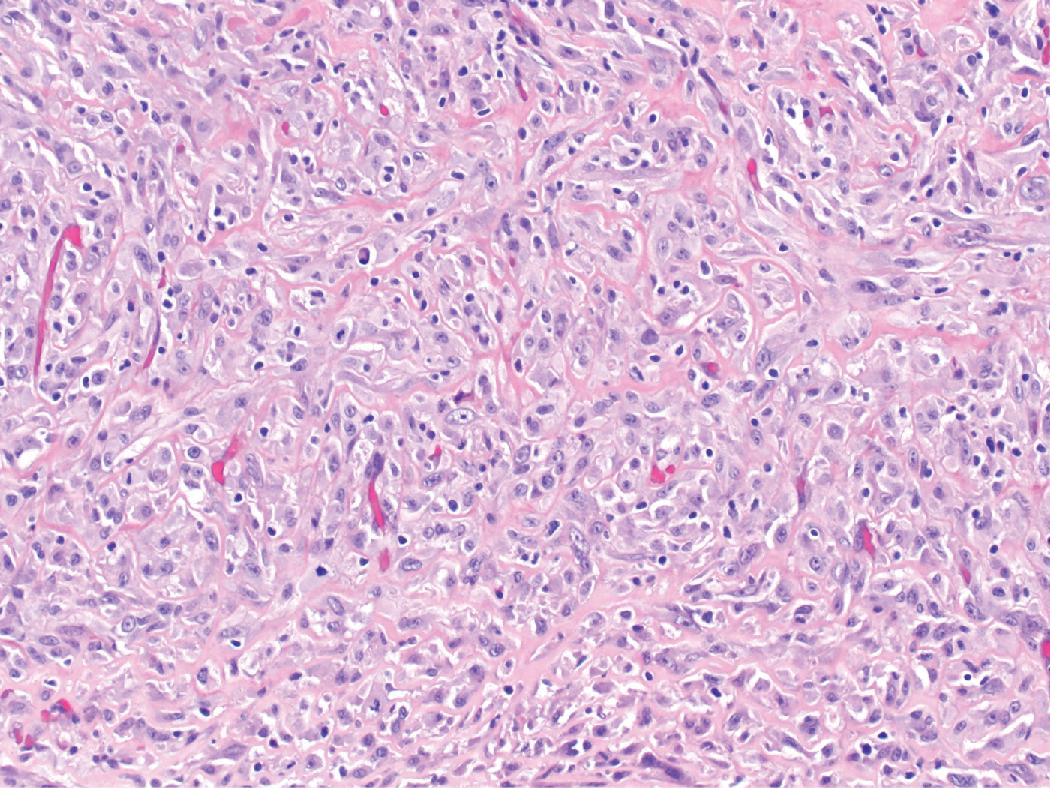
Lymphohistiocytoid mesothelioma , is a rare and distinctive variant of mesothelioma with dense lymphoid infiltrates significantly obscuring tumor cells showing histiocytoid morphology, somewhat resembling lymphoepithelioma-like carcinoma ( Fig. 15.21 ). Such tumors can be epithelioid or sarcomatoid, but the main diagnostic challenge lies in the fact that such tumors are obscured by inflammation and can be easily misinterpreted as a benign inflammatory process if the neoplastic cells are not recognized. IHC for cytokeratins can be very helpful in such cases to visualize the tumor cells.
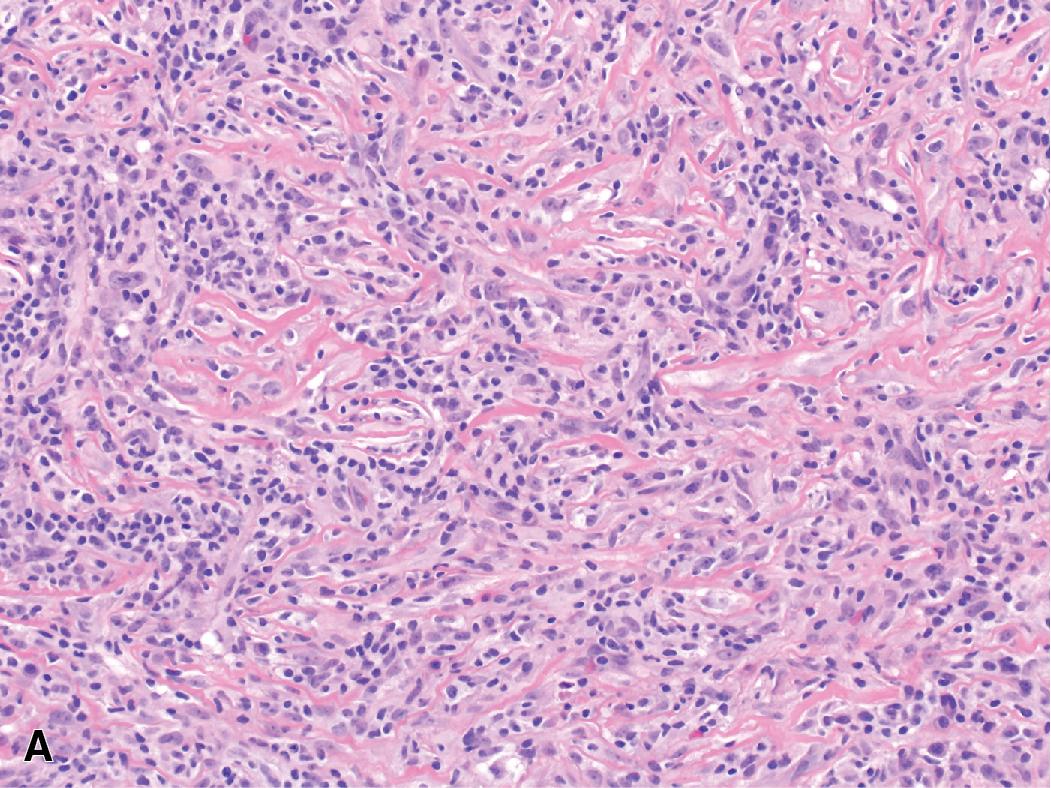
The natural history of pleural mesothelioma is an adverse one. The usual survival of patients with this tumor is less than 15 months, with death typically occurring because of cardiorespiratory failure or pulmonary infection. , , The sarcomatoid type of mesothelioma appears to be the most aggressive, and it is associated with only a brief survival after diagnosis. A peculiarity of sarcomatoid mesothelioma is its tendency to grow through surgical defects in the chest wall, represented by either thoracotomy incisions or thoracostomy sites. Metastases outside the thorax are relatively rare, although they have been reported in a small minority of cases in such sites as liver, bones, and skin.
Treatment of mesothelioma is generally supportive, inasmuch as radiation and chemotherapy produce little survival benefit, although multimodality therapy is recommended in patients with early-stage disease and good performance status. Notably, recent clinical trials of immune checkpoint inhibitors alone or combined with conventional chemotherapy have shown promising results as a treatment approach for mesothelioma. , Extrapleural pneumonectomy is still a controversial surgical approach to mesothelioma; its proponents claim a definite decrease in mortality in the operative group, as compared with stage- and age-matched controls managed by other means. However, those observations have not been supported by other studies. Therefore, this type of radical surgery is often only offered to selected patients with excellent performance status and purely epithelioid tumors.
Almost all primary lung malignancies represent carcinomas, and as already discussed above, sarcomatoid carcinoma generally leads the differential diagnosis when a solitary spindle cell malignancy is encountered in the lung. The presence of cytokeratin expression is helpful and can support a diagnosis of sarcomatoid carcinoma in an appropriate clinical setting, but the absence of this finding does not exclude the diagnosis, particularly in the small biopsy setting. If a definite adenocarcinoma, squamous cell carcinoma, adenosquamous carcinoma, or large cell carcinoma component is present, the tumor is regarded as pleomorphic carcinoma (a morphologic subtype of sarcomatoid carcinoma) even if the malignant spindle cell component shows complete absence of cytokeratin expression. A diagnosis of primary sarcoma in the lung is generally regarded as a diagnosis of exclusion and should only made after thoroughly excluding sarcomatoid carcinoma with multiple negative cytokeratin immunostains and other relevant markers (e.g., EMA, TTF-1, p40, claudin-4) and positive ancillary studies supporting an alternative diagnosis.
The lungs represent the most common site of metastasis for most sarcoma types. As already discussed, the vast majority of primary spindle cell malignancies in the lungs represent sarcomatoid carcinomas, but it should be remembered that a variety of sarcomas may also show some keratin expression, and metastatic sarcomas may enter the differential diagnosis in some cases, particularly in the setting of multiple lung nodules or masses. Knowledge of a prior history of soft tissue sarcoma in a patient can greatly aid the pathologist in recognizing metastatic sarcoma in the lungs, and an appropriate immunohistochemical workup can further support the diagnosis and exclude other entities in challenging cases. If a history of prior sarcoma is unavailable and metastatic sarcoma is suspected by the pathologist, an appropriate whole-body clinical examination and imaging workup that also includes the extremities may be helpful to resolve otherwise indeterminate cases.
Most if not all melanomas encountered in the lung represent metastases, whether they are spindled or epithelioid in morphology, and any melanoma encountered in the lung should be regarded as metastatic until proven otherwise. Melanomas arising primarily in the lung are extraordinarily rare; the literature contains sparse reports on this topic. Rigorous criteria have been proposed for primary melanoma of the lung, but this diagnosis cannot be established with absolute certainty even in the absence of a prior history of melanoma, because of the well-known capacity for spontaneous regression of melanomas in cutaneous or mucosal sites. Furthermore, the recent identification of ultraviolet radiation-associated mutational signatures in 100% of tested “lung-only melanomas” supports their origin from occult cutaneous primaries and brings the veracity of the concept of primary pulmonary melanoma into question. However, the presence of a cytologically atypical in situ melanocytic proliferation in adjacent bronchial mucosa in other cases ( Fig. 15.22 ) supports the notion that at least some melanomas may truly arise in the lower respiratory tract. Even so, some might argue that this represents a form of pagetoid spread or mucosal colonization rather than true in situ growth and may not necessarily provide definitive evidence of origin in the bronchus. To seriously consider a diagnosis of primary melanoma of the lung, there obviously must be no prior history of a malignant melanocytic tumor of the skin or ocular uveal tract, and clinical examination for occult melanomas in the integument, nailbeds, eyes, nasal cavity, paranasal sinuses, oral cavity, esophagus, anus, rectum, vulva, and leptomeninges should be negative. Even in such cases, the diagnosis of primary pulmonary melanoma should always be viewed with skepticism.
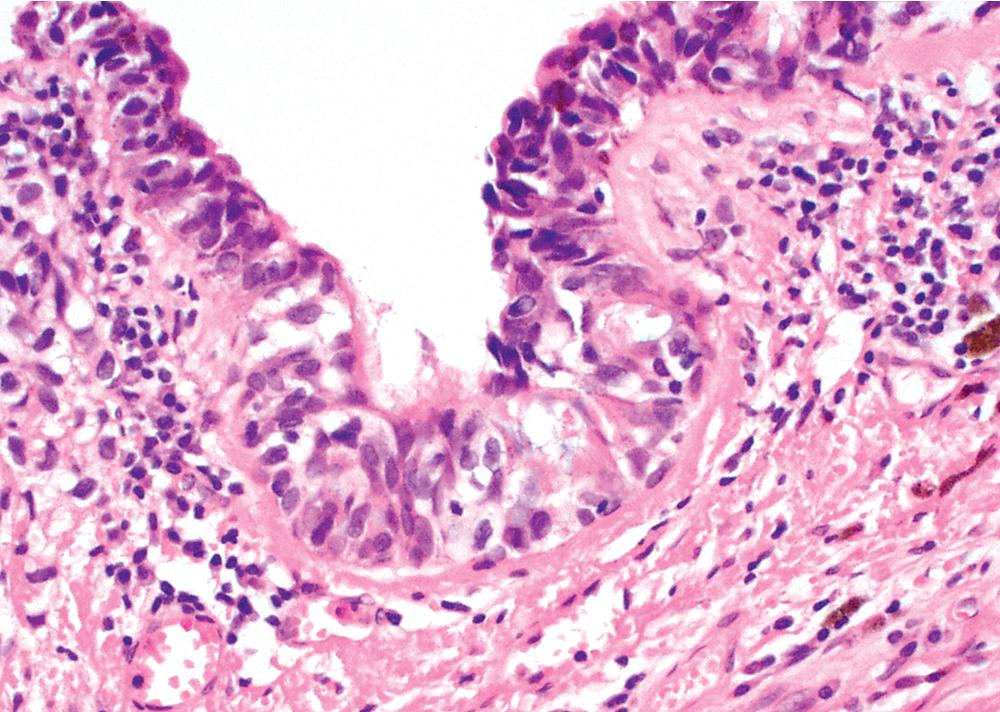
In several reported cases of primary melanoma of the lung, the lesions have been centered in large airways, including the trachea and major bronchi. , , , Grossly, these tumors are generally polypoid, endoluminal masses that are partially or completely obstructing, or they may present as nodules or masses within the lung parenchyma. In addition, they are characteristically colored in shades of brown or black but may occasionally be amelanotic (tan-gray). Regardless of their site of origin (primary vs. metastatic), melanomas in the lung are composed of heterogeneously pigmented and variably pleomorphic cells that range from epithelioid to spindled in configuration with occasional gigantiform figures; overtly sarcoma-like lesions are certainly part of the repertoire of these neoplasms ( Fig. 15.23 ). Indeed, divergent differentiation into chondroosseous-like tissue has been reported in melanomas. Immunophenotypic absence of keratin expression and positive immunostaining for S100 protein, SOX10, HMB–45, melan-A, and/or tyrosinase are useful in confirming the presence of melanocytic differentiation and excluding spindle cell melanomas from sarcomatoid carcinoma and other entities. It should be noted that in the setting of spindle cell melanomas, S100 protein and SOX10 are the most sensitive markers, and the other more specific melanocytic markers may be negative.
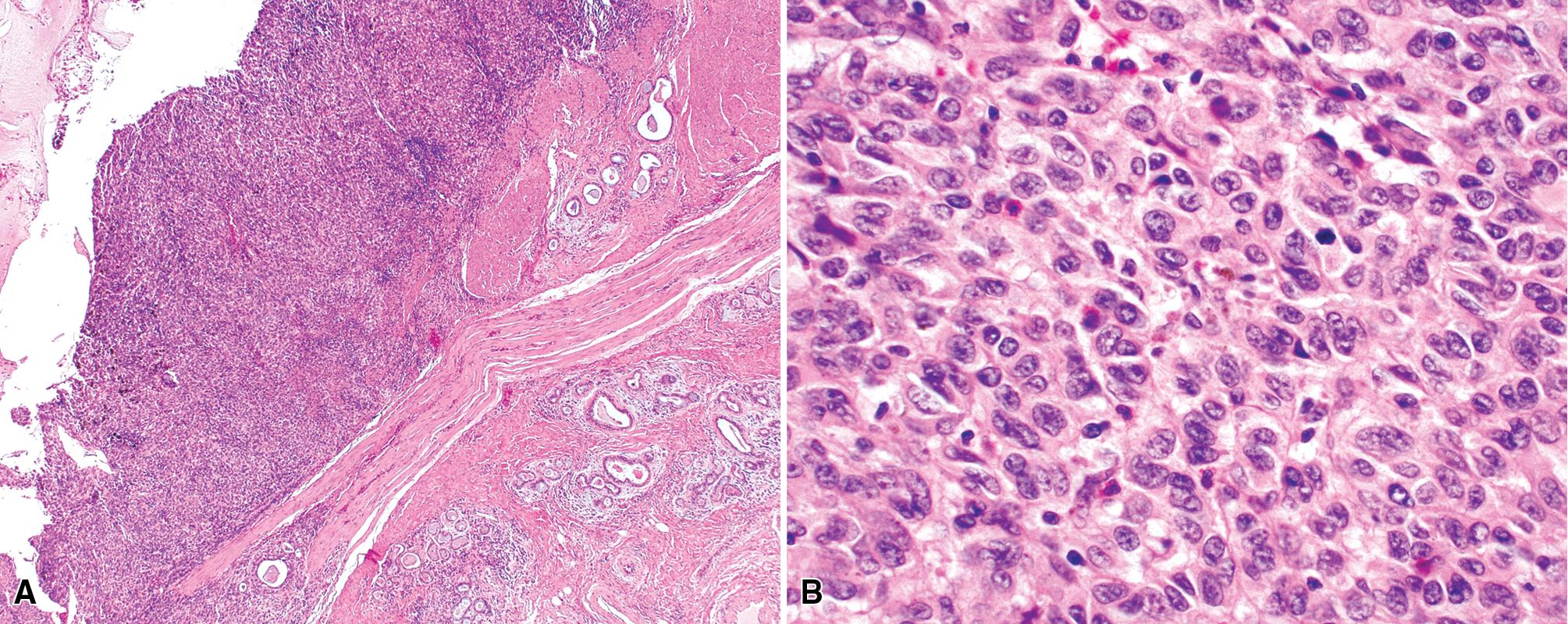
Although it is technically not part of the respiratory tract, the pulmonary arterial trunk is an appropriate topic for this discussion that centers on intrathoracic mesenchymal malignancies. For more than 75 years, it has been known that this vascular segment may serve as the point of origin for sarcomas with diverse histologic features, and clinical manifestations that are just as variable. To date, several hundred intimal sarcomas of the pulmonary trunk have been documented. ,
Patients with intimal sarcoma are adults in middle life or beyond, and there is no predilection for either gender. They present with a variety of potential symptoms and signs, the most common of which simulate the findings of right-sided cardiac failure or pulmonary thromboembolic disease. , Patients often complain of intractable cough, progressive dyspnea, and dull chest pain that may increase with exertion; cardiac tamponade has rarely been observed. Neck veins may be distended, a loud precordial systolic heart murmur may be audible at the upper left sternal border, and the patient may manifest the complete clinical scenario of anasarca. , However, cardiac imaging studies demonstrate no evidence of ventricular hypokinesis or perfusion abnormalities.
In the era before modern imaging studies, the diagnosis of intimal sarcoma was usually made for the first time at autopsy. However, current imaging modalities are now capable of revealing the tumor in question rather easily ( Fig. 15.24 ). It takes the form of a partially obstructing, endoluminal mass at the level of the right ventricular outlet or above it, and may extend over a span of several centimeters. Attachment of the lesion to the arterial wall is variable in character and may be sessile or pedunculated. The neoplasm is typically somewhat heterogeneous in density and greatly variable in size from case to case. ,
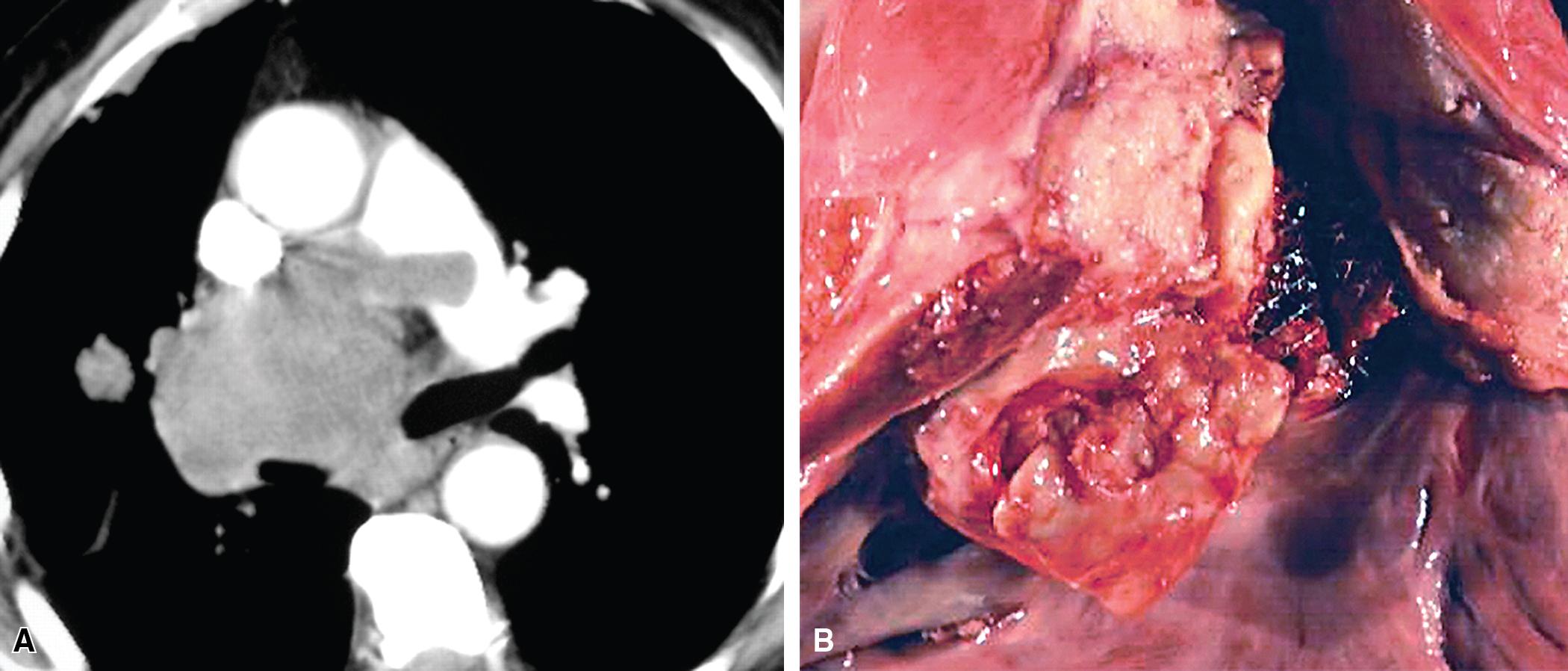
The preoperative diagnosis of intimal sarcoma is typically one that may not involve the pathologist, inasmuch as biopsy of an intravascular mass in the right ventricular outlet is a challenging procedure. Thus, a pathologist’s first encounter with such lesions may be in the frozen-section laboratory during a definitive surgical procedure. In this context, it is important to realize that a firm diagnosis of a particular sarcoma type (or even of a malignancy) may not be an easy proposition. Some intimal sarcomas take the form of rather paucicellular myxoid proliferations with surprisingly bland cytologic characteristics, whereas others are anaplastic tumors that defy easy classification under the microscope ( Fig. 15.25 ). Intimal sarcomas show a wide diversity of morphologies that may mimic myxofibrosarcoma, angiosarcoma, leiomyosarcoma, rhabdomyosarcoma, chondrosarcoma, and osteosarcoma, among other sarcoma types, but most intimal sarcomas generally have characteristics of high-grade spindle cell or pleomorphic sarcomas that would fall under the spectrum of undifferentiated pleomorphic sarcomas of soft tissue. , Occasional low-grade variants can closely simulate an intracardiac myxoma or organizing mural thrombus. Though intimal sarcomas display a nonspecific immunophenotype that may include evidence of myofibroblastic differentiation (weak “tram-track” staining for SMA or desmin without staining for a variety of other markers), the discovery of amplification of the MDM2 gene region in many cases of intimal sarcoma has provided a convenient diagnostic marker that can be detected by fluorescence in situ hybridization or immunohistochemistry in problematic cases or in the small biopsy setting. ,
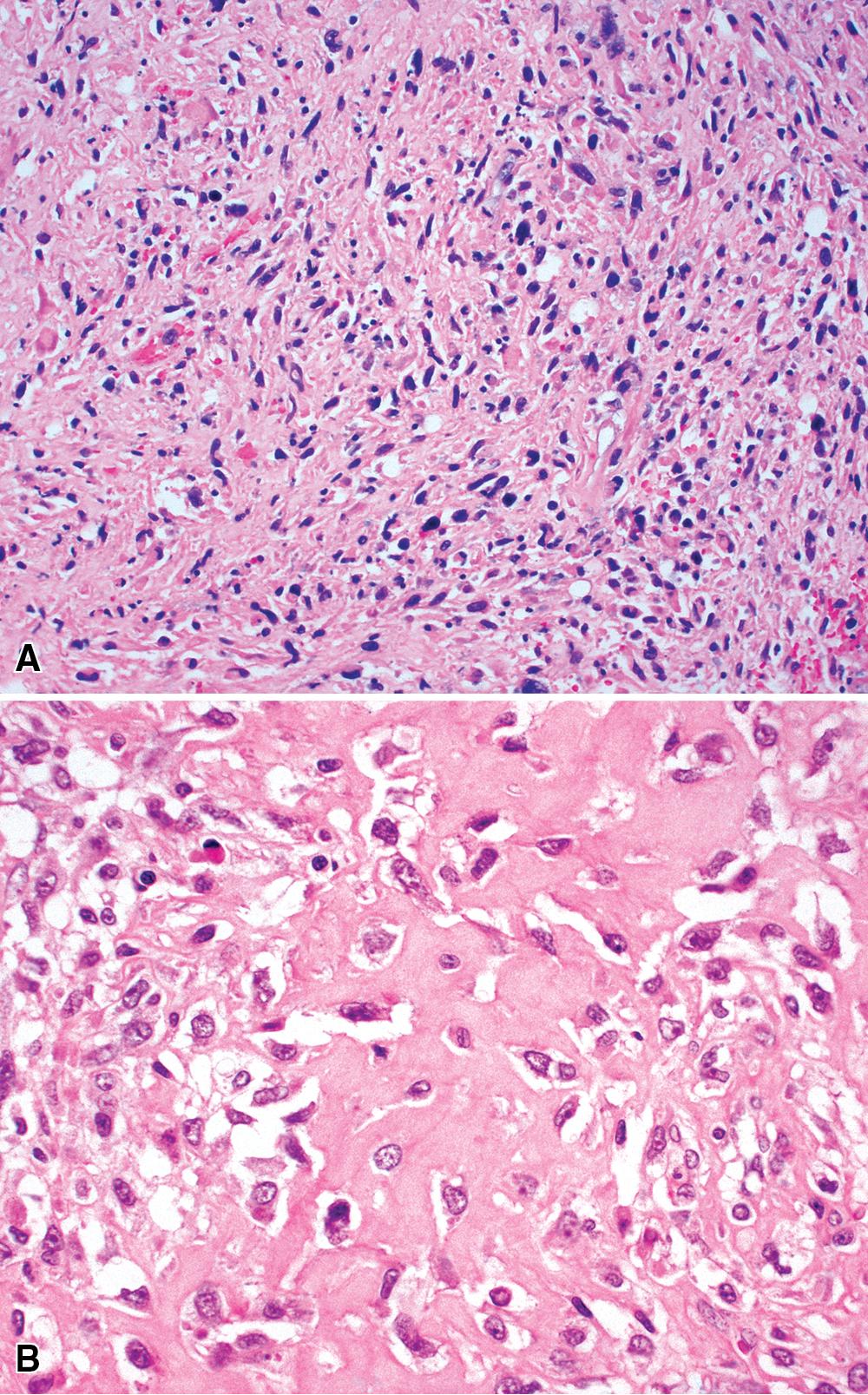
Because of the dominance of autopsy reports in the earliest literature on intimal sarcoma, the recommended therapy for this tumor must still be considered evolutionary. At the present time, providing that a firm radiologic diagnosis can be made or a frozen-section interpretation of sarcoma can be rendered, the surgeon may perform an en bloc resection of the pulmonary trunk and its luminal tumor contents, followed by interposition of a synthetic graft. This is probably the most definitive approach to operative therapy, inasmuch as it is difficult to determine the boundaries of intramural tumor growth by visual inspection. The latter point makes more limited vascular resections and reconstructions a tenuous enterprise.
Extension of the tumor through the wall of the pulmonary artery is the single most important piece of pathologic information in cases of intimal sarcoma, since histologic grading generally does not appear to correlate with tumor behavior in a consistent fashion. , In addition, the surgeon’s or radiologist’s estimation of whether the lesion is pedunculated or sessile has considerable importance. Tumors with a narrow stalk tend to “flutter” in the stream of ejected blood in the ventricular outflow tract, and pieces of the neoplasm may be embolized into the lungs. This phenomenon is not as common with lesions that assume a broadly based sessile macroscopic growth pattern. Cases demonstrating metastasis or obvious extravascular spread may be managed with radiation or chemotherapy. However, there are no unified recommendations for the use of these treatments, and their implementation has produced discouraging results thus far.
The most common anatomic locations for leiomyosarcomas in general are the uterus, retroperitoneum, and soft tissue of the extremities. Primary pulmonary leiomyosarcomas are very rare and presumably take their origins from bronchial or pulmonary vascular smooth muscle. Only three cases of leiomyosarcoma were found among roughly 10,000 primary malignancies of the lung at one large American medical center between 1980 and 1990. Because secondary pulmonary involvement by metastatic smooth muscle tumors is a relatively frequent event, the diagnosis of primary pulmonary leiomyosarcoma requires exclusion of an occult extrathoracic neoplasm presenting with a single “herald” metastasis to the lung. ,
Primary leiomyosarcomas in the lung may be endobronchial or intraparenchymal, with the former being more common in children and the latter more common in adults. , Although data in the literature is limited, primary pulmonary leiomyosarcomas are reported to be more common in males. Unlike lung carcinoma, leiomyosarcoma is not associated with cigarette smoking or other inhaled carcinogens. Most patients with primary pulmonary leiomyosarcoma (particularly its endobronchial form) are symptomatic, often complaining of cough, hemoptysis, or chest pain. However, intraparenchymal lesions may be discovered incidentally on chest radiographs. On imaging studies, this tumor usually takes the form of a discrete mass ( Fig. 15.26 ), sometimes with cavitation or cyst formation. Leiomyosarcomas are extremely rare as primary pleural neoplasms, with less than 25 well-documented cases in the literature.

Intraparenchymal tumors range from 3 to 15 cm in maximum dimension; they are well circumscribed, white to yellowish tan, and variably firm. Cut surfaces of these neoplasms commonly show hemorrhagic and necrotic areas. Endobronchial tumors are often smaller than intraparenchymal lesions, presumably because of confinement by the bronchial walls and/or development of obstructive symptoms thus bringing the patient to clinical attention earlier in the disease course.
Histologic features mirror those of leiomyosarcomas elsewhere in the body. On low-power magnification, there are well-formed, intersecting fascicles of spindled cells that are arranged somewhat haphazardly ( Fig. 15.27 ). The neoplastic cells have cigar-shaped nuclei with blunt ends, a moderate amount of eosinophilic cytoplasm, and indistinct cell borders ( Fig. 15.28 ). Fascicles cut in cross section demonstrate characteristic intracellular perinuclear lucencies. Prominent myxoid stromal change may be observed. Transthoracic fine-needle aspiration may be attempted if the lesion is large and peripherally located, and cytologic preparations typically show a discohesive population of relatively monotonous spindle cells with blunt-ended fusiform nuclei. Mitotic figures and nuclear pleomorphism are variably seen; some lesions may exhibit more epithelioid cytomorphology ( Fig. 15.29 ).
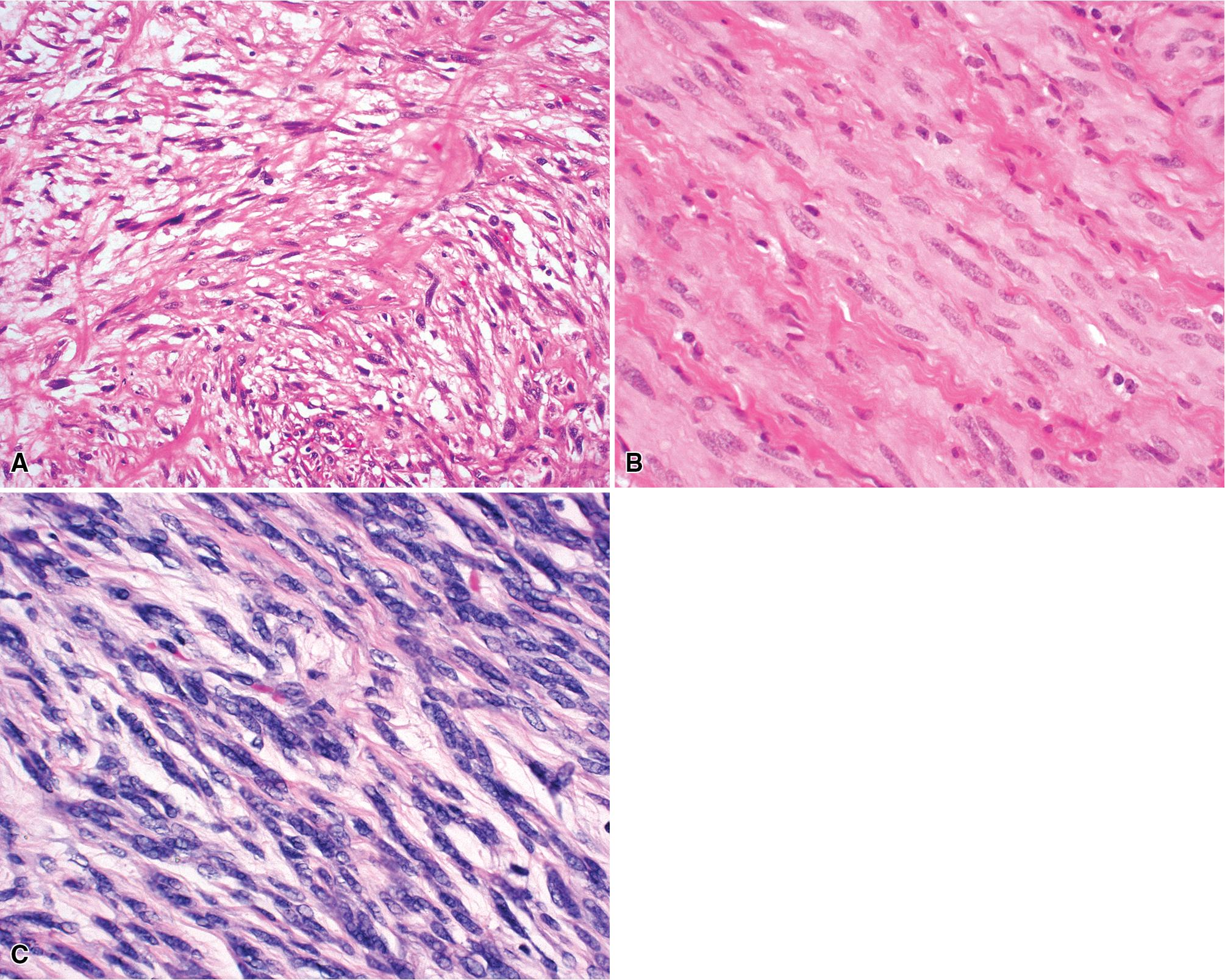
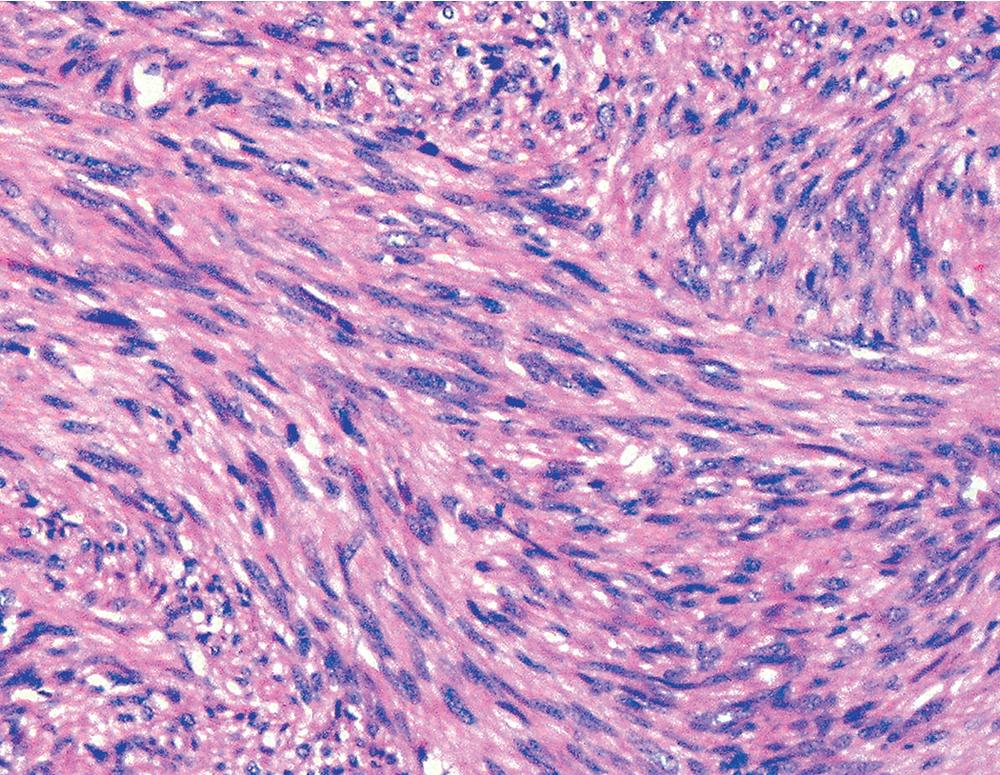
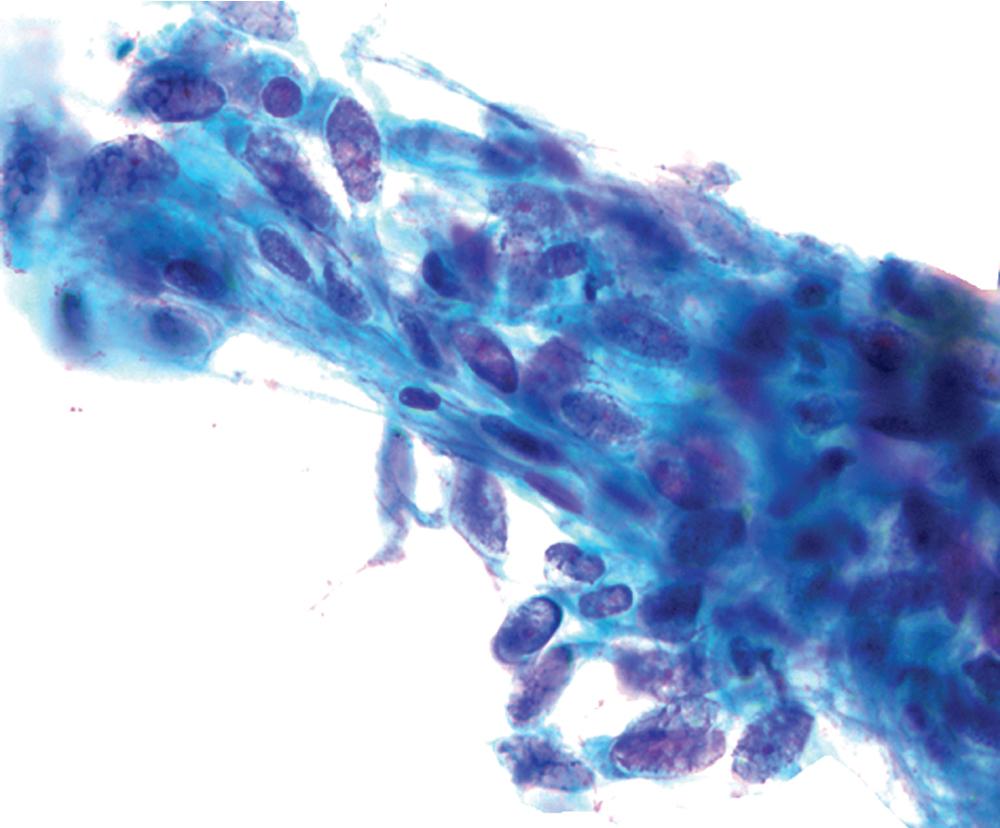
The differential diagnosis of primary pulmonary leiomyosarcoma includes sarcomatoid carcinoma and other spindle cell malignancies, in addition to metastatic leiomyosarcoma from other anatomic sites. IHC is helpful in confirming smooth muscle differentiation in the tumor, with strong and diffuse expression of desmin, smooth muscle actin, muscle-specific actin, calponin, and/or h-caldesmon being characteristic, but it should be noted that other tumors may show heterologous leiomyosarcomatous elements (e.g., sarcomatoid carcinoma). It should also be noted that other sarcomas and sarcomatoid malignancies can show nonspecific myofibroblastic differentiation that can mimic smooth muscle immunophenotypically, with patchy, weak, or “tram track”-like patterns of staining of intracytoplasmic contractile filaments for one or more of the aforementioned markers, mandating careful interpretation of IHC in the broader morphologic context. It is also important to remember that benign smooth muscle proliferations may be seen in the lung, often as a metaplastic change in the setting of fibrotic interstitial lung disease, or as a component of a pulmonary hamartoma.
The natural history of primary pulmonary leiomyosarcoma and its responses to various therapeutic regimens are difficult to predict because of the rarity of this neoplasm. However, there is generally a consensus that surgical resection is the treatment of choice, , and that it produces a survival rate of 45% to 50% at 5 years. Survival for as long as 15 to 30 years has been documented in some cases. , However, pulmonary leiomyosarcomas appear to be relatively resistant to radiation and chemotherapy. , Various prognostic variables have been discussed in connection with these lesions. , Endobronchial tumors are thought to be less aggressive than parenchymal neoplasms, largely because the former tend to be smaller and are diagnosed earlier. It follows, therefore, that tumor size is an important indicator of biologic behavior for all pulmonary leiomyosarcomas. The scope of mitotic activity may affect prognosis as well. In an older study, a rate of 8 or fewer mitotic figures per 10 high-power fields was associated with infrequent metastasis and a generally favorable clinical outcome.
Undifferentiated pleomorphic sarcoma (UPS) is a soft tissue sarcoma of older adults that develops most frequently in the extremities. UPS is a diagnosis of exclusion, representing a heterogeneous group of high-grade pleomorphic spindle cell malignancies showing no evidence of a specific line of differentiation. UPS was formerly known by the historical term “malignant fibrous histiocytoma,” a now obsolete misnomer that is no longer recommended, with UPS representing a more accurate term that is currently endorsed by the WHO. Although UPS is relatively common in general, this tumor is extremely rare as a primary pulmonary malignancy, and it may be nearly impossible to adequately exclude a keratin-negative sarcomatoid carcinoma based a small biopsy sample. In an older published series of 200 cases of “malignant fibrous histiocytoma” that would likely now be classified as UPS, the lungs were the most common site of metastases. Thus, exclusion of an occult soft tissue tumor is necessary before a diagnosis of primary pulmonary UPS can be made. Currently, there are fewer than 100 reported cases of primary pulmonary UPS in the English literature.
In general, UPS is a neoplasm of patients who are in late middle age, with a median of 54 years. However, its occasional occurrence in children and young adults has also been reported. , No consistent predilection for either gender is seen. Previous radiation is a pathogenetic risk factor for tumors arising in soft tissue, and the literature similarly contains sporadic reports of primary pulmonary UPS presenting in patients who have received radiation therapy previously. Clinical and radiographic features of this tumor are nonspecific, and a distinction from the much more common epithelial tumors of the lungs requires tissue examination. Most patients present with symptoms of cough, chest pain, hemoptysis, or dyspnea. Chest x-rays generally show a solitary mass with a nondescript appearance and a relatively homogeneous density on CT or MRI studies.
Become a Clinical Tree membership for Full access and enjoy Unlimited articles
If you are a member. Log in here